The Evolution and Development of Travel and Tourism
VerifiedAdded on 2020/07/23
|23
|3563
|156
AI Summary
The assignment provides a comprehensive overview of the history and growth of the tourism industry, highlighting important milestones and developments from prehistoric times to the present day. It discusses the early forms of travel, the impact of industrial revolution on tourism, and the evolution of tour packages and services. The assignment also defines tourism and its various forms, covering both demand and supply aspects.
Contribute Materials
Your contribution can guide someone’s learning journey. Share your
documents today.
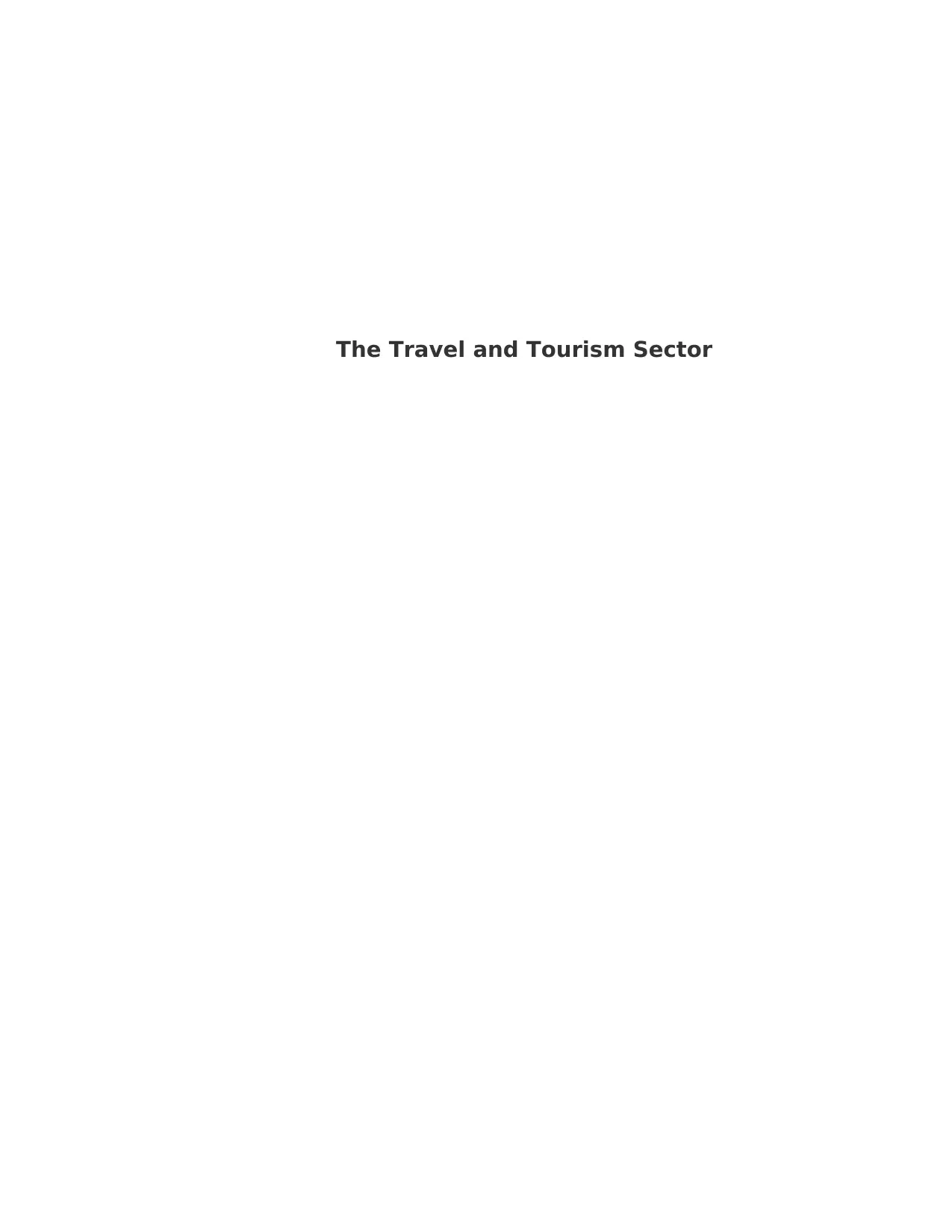
The Travel and Tourism Sector
Secure Best Marks with AI Grader
Need help grading? Try our AI Grader for instant feedback on your assignments.
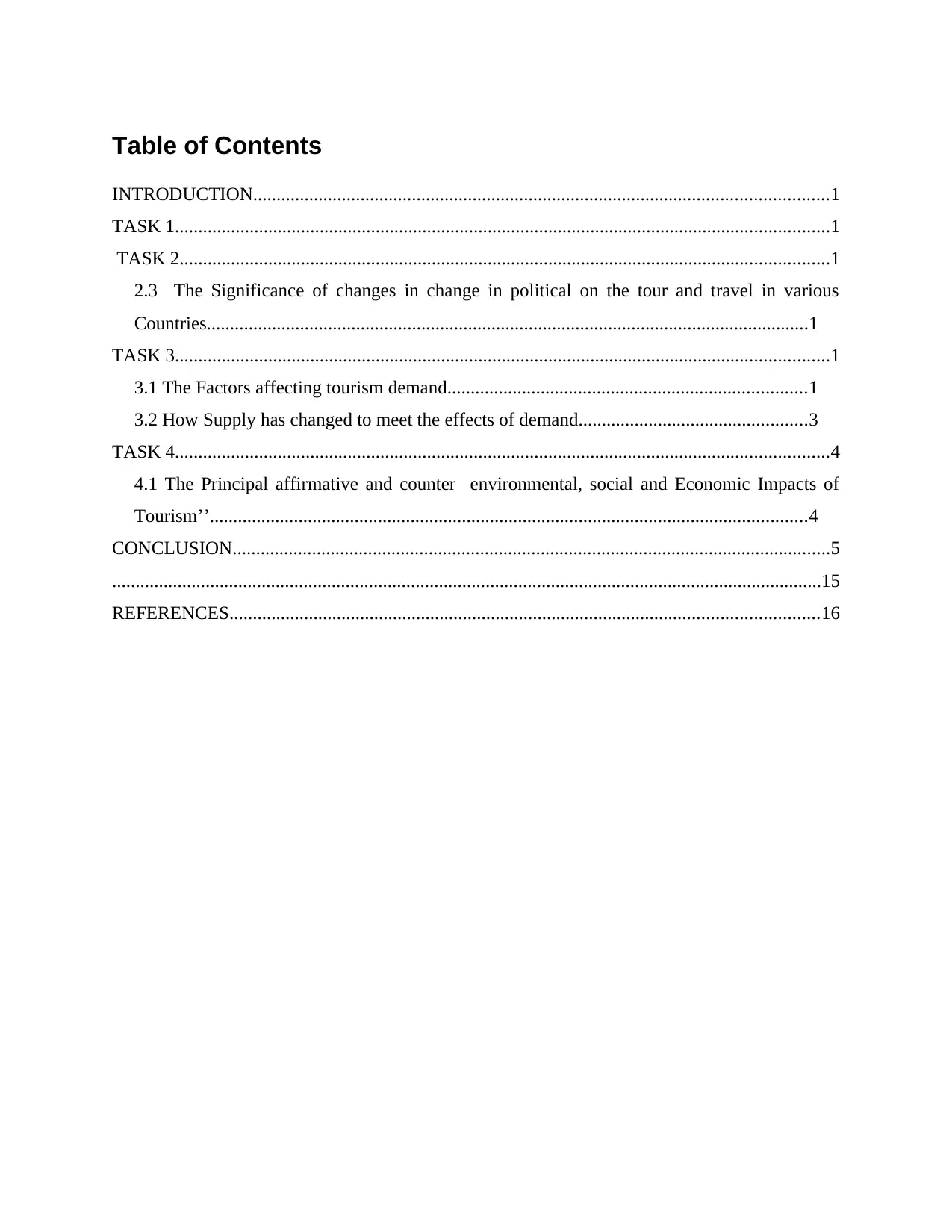
Table of Contents
INTRODUCTION...........................................................................................................................1
TASK 1............................................................................................................................................1
TASK 2...........................................................................................................................................1
2.3 The Significance of changes in change in political on the tour and travel in various
Countries.................................................................................................................................1
TASK 3............................................................................................................................................1
3.1 The Factors affecting tourism demand.............................................................................1
3.2 How Supply has changed to meet the effects of demand.................................................3
TASK 4............................................................................................................................................4
4.1 The Principal affirmative and counter environmental, social and Economic Impacts of
Tourism’’................................................................................................................................4
CONCLUSION................................................................................................................................5
........................................................................................................................................................15
REFERENCES..............................................................................................................................16
INTRODUCTION...........................................................................................................................1
TASK 1............................................................................................................................................1
TASK 2...........................................................................................................................................1
2.3 The Significance of changes in change in political on the tour and travel in various
Countries.................................................................................................................................1
TASK 3............................................................................................................................................1
3.1 The Factors affecting tourism demand.............................................................................1
3.2 How Supply has changed to meet the effects of demand.................................................3
TASK 4............................................................................................................................................4
4.1 The Principal affirmative and counter environmental, social and Economic Impacts of
Tourism’’................................................................................................................................4
CONCLUSION................................................................................................................................5
........................................................................................................................................................15
REFERENCES..............................................................................................................................16
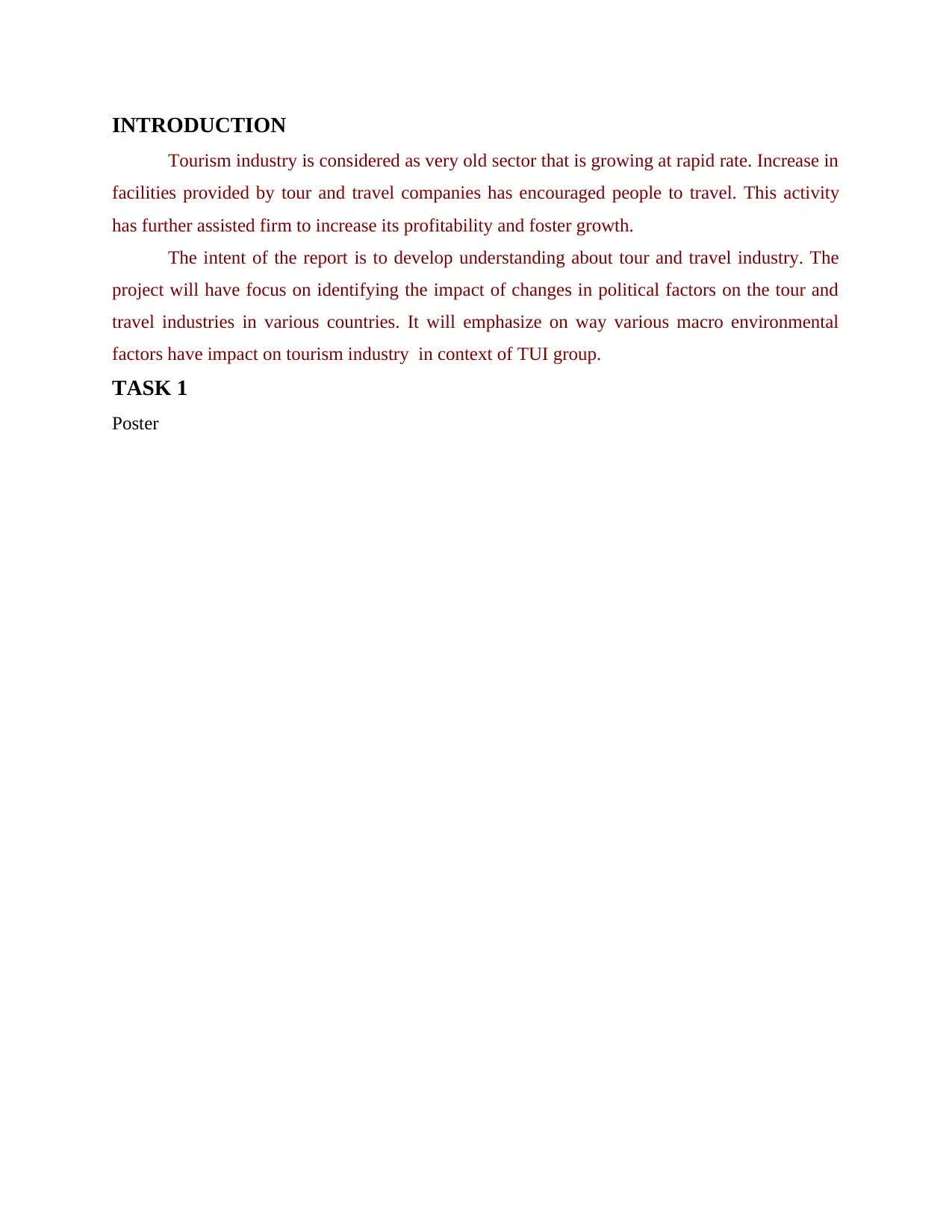
INTRODUCTION
Tourism industry is considered as very old sector that is growing at rapid rate. Increase in
facilities provided by tour and travel companies has encouraged people to travel. This activity
has further assisted firm to increase its profitability and foster growth.
The intent of the report is to develop understanding about tour and travel industry. The
project will have focus on identifying the impact of changes in political factors on the tour and
travel industries in various countries. It will emphasize on way various macro environmental
factors have impact on tourism industry in context of TUI group.
TASK 1
Poster
Tourism industry is considered as very old sector that is growing at rapid rate. Increase in
facilities provided by tour and travel companies has encouraged people to travel. This activity
has further assisted firm to increase its profitability and foster growth.
The intent of the report is to develop understanding about tour and travel industry. The
project will have focus on identifying the impact of changes in political factors on the tour and
travel industries in various countries. It will emphasize on way various macro environmental
factors have impact on tourism industry in context of TUI group.
TASK 1
Poster
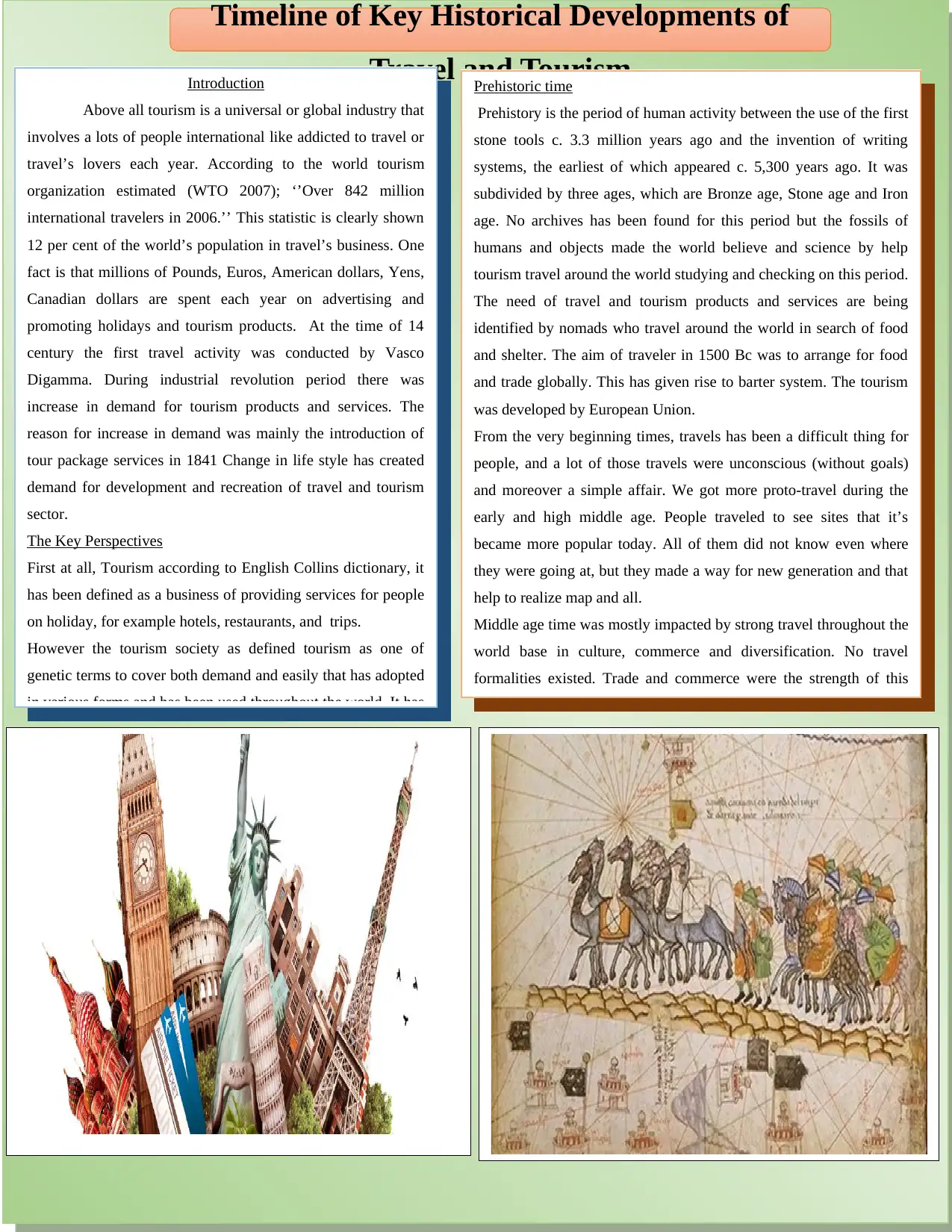
Timeline of Key Historical Developments of
Travel and TourismIntroduction
Above all tourism is a universal or global industry that
involves a lots of people international like addicted to travel or
travel’s lovers each year. According to the world tourism
organization estimated (WTO 2007); ‘’Over 842 million
international travelers in 2006.’’ This statistic is clearly shown
12 per cent of the world’s population in travel’s business. One
fact is that millions of Pounds, Euros, American dollars, Yens,
Canadian dollars are spent each year on advertising and
promoting holidays and tourism products. At the time of 14
century the first travel activity was conducted by Vasco
Digamma. During industrial revolution period there was
increase in demand for tourism products and services. The
reason for increase in demand was mainly the introduction of
tour package services in 1841 Change in life style has created
demand for development and recreation of travel and tourism
sector.
The Key Perspectives
First at all, Tourism according to English Collins dictionary, it
has been defined as a business of providing services for people
on holiday, for example hotels, restaurants, and trips.
However the tourism society as defined tourism as one of
genetic terms to cover both demand and easily that has adopted
in various forms and has been used throughout the world. It has
Prehistoric time
Prehistory is the period of human activity between the use of the first
stone tools c. 3.3 million years ago and the invention of writing
systems, the earliest of which appeared c. 5,300 years ago. It was
subdivided by three ages, which are Bronze age, Stone age and Iron
age. No archives has been found for this period but the fossils of
humans and objects made the world believe and science by help
tourism travel around the world studying and checking on this period.
The need of travel and tourism products and services are being
identified by nomads who travel around the world in search of food
and shelter. The aim of traveler in 1500 Bc was to arrange for food
and trade globally. This has given rise to barter system. The tourism
was developed by European Union.
From the very beginning times, travels has been a difficult thing for
people, and a lot of those travels were unconscious (without goals)
and moreover a simple affair. We got more proto-travel during the
early and high middle age. People traveled to see sites that it’s
became more popular today. All of them did not know even where
they were going at, but they made a way for new generation and that
help to realize map and all.
Middle age time was mostly impacted by strong travel throughout the
world base in culture, commerce and diversification. No travel
formalities existed. Trade and commerce were the strength of this
period.
Travel and TourismIntroduction
Above all tourism is a universal or global industry that
involves a lots of people international like addicted to travel or
travel’s lovers each year. According to the world tourism
organization estimated (WTO 2007); ‘’Over 842 million
international travelers in 2006.’’ This statistic is clearly shown
12 per cent of the world’s population in travel’s business. One
fact is that millions of Pounds, Euros, American dollars, Yens,
Canadian dollars are spent each year on advertising and
promoting holidays and tourism products. At the time of 14
century the first travel activity was conducted by Vasco
Digamma. During industrial revolution period there was
increase in demand for tourism products and services. The
reason for increase in demand was mainly the introduction of
tour package services in 1841 Change in life style has created
demand for development and recreation of travel and tourism
sector.
The Key Perspectives
First at all, Tourism according to English Collins dictionary, it
has been defined as a business of providing services for people
on holiday, for example hotels, restaurants, and trips.
However the tourism society as defined tourism as one of
genetic terms to cover both demand and easily that has adopted
in various forms and has been used throughout the world. It has
Prehistoric time
Prehistory is the period of human activity between the use of the first
stone tools c. 3.3 million years ago and the invention of writing
systems, the earliest of which appeared c. 5,300 years ago. It was
subdivided by three ages, which are Bronze age, Stone age and Iron
age. No archives has been found for this period but the fossils of
humans and objects made the world believe and science by help
tourism travel around the world studying and checking on this period.
The need of travel and tourism products and services are being
identified by nomads who travel around the world in search of food
and shelter. The aim of traveler in 1500 Bc was to arrange for food
and trade globally. This has given rise to barter system. The tourism
was developed by European Union.
From the very beginning times, travels has been a difficult thing for
people, and a lot of those travels were unconscious (without goals)
and moreover a simple affair. We got more proto-travel during the
early and high middle age. People traveled to see sites that it’s
became more popular today. All of them did not know even where
they were going at, but they made a way for new generation and that
help to realize map and all.
Middle age time was mostly impacted by strong travel throughout the
world base in culture, commerce and diversification. No travel
formalities existed. Trade and commerce were the strength of this
period.
Secure Best Marks with AI Grader
Need help grading? Try our AI Grader for instant feedback on your assignments.
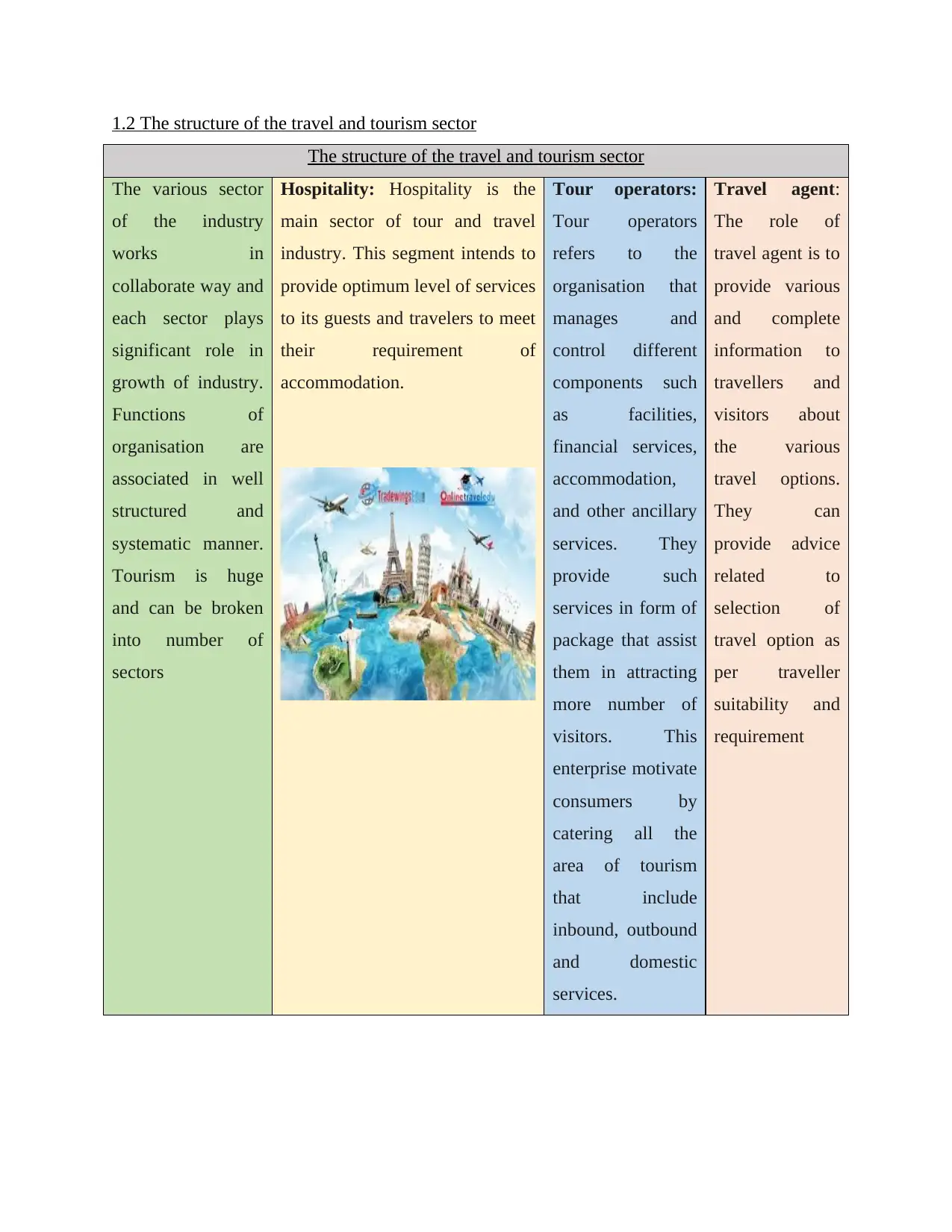
1.2 The structure of the travel and tourism sector
The structure of the travel and tourism sector
The various sector
of the industry
works in
collaborate way and
each sector plays
significant role in
growth of industry.
Functions of
organisation are
associated in well
structured and
systematic manner.
Tourism is huge
and can be broken
into number of
sectors
Hospitality: Hospitality is the
main sector of tour and travel
industry. This segment intends to
provide optimum level of services
to its guests and travelers to meet
their requirement of
accommodation.
Tour operators:
Tour operators
refers to the
organisation that
manages and
control different
components such
as facilities,
financial services,
accommodation,
and other ancillary
services. They
provide such
services in form of
package that assist
them in attracting
more number of
visitors. This
enterprise motivate
consumers by
catering all the
area of tourism
that include
inbound, outbound
and domestic
services.
Travel agent:
The role of
travel agent is to
provide various
and complete
information to
travellers and
visitors about
the various
travel options.
They can
provide advice
related to
selection of
travel option as
per traveller
suitability and
requirement
The structure of the travel and tourism sector
The various sector
of the industry
works in
collaborate way and
each sector plays
significant role in
growth of industry.
Functions of
organisation are
associated in well
structured and
systematic manner.
Tourism is huge
and can be broken
into number of
sectors
Hospitality: Hospitality is the
main sector of tour and travel
industry. This segment intends to
provide optimum level of services
to its guests and travelers to meet
their requirement of
accommodation.
Tour operators:
Tour operators
refers to the
organisation that
manages and
control different
components such
as facilities,
financial services,
accommodation,
and other ancillary
services. They
provide such
services in form of
package that assist
them in attracting
more number of
visitors. This
enterprise motivate
consumers by
catering all the
area of tourism
that include
inbound, outbound
and domestic
services.
Travel agent:
The role of
travel agent is to
provide various
and complete
information to
travellers and
visitors about
the various
travel options.
They can
provide advice
related to
selection of
travel option as
per traveller
suitability and
requirement
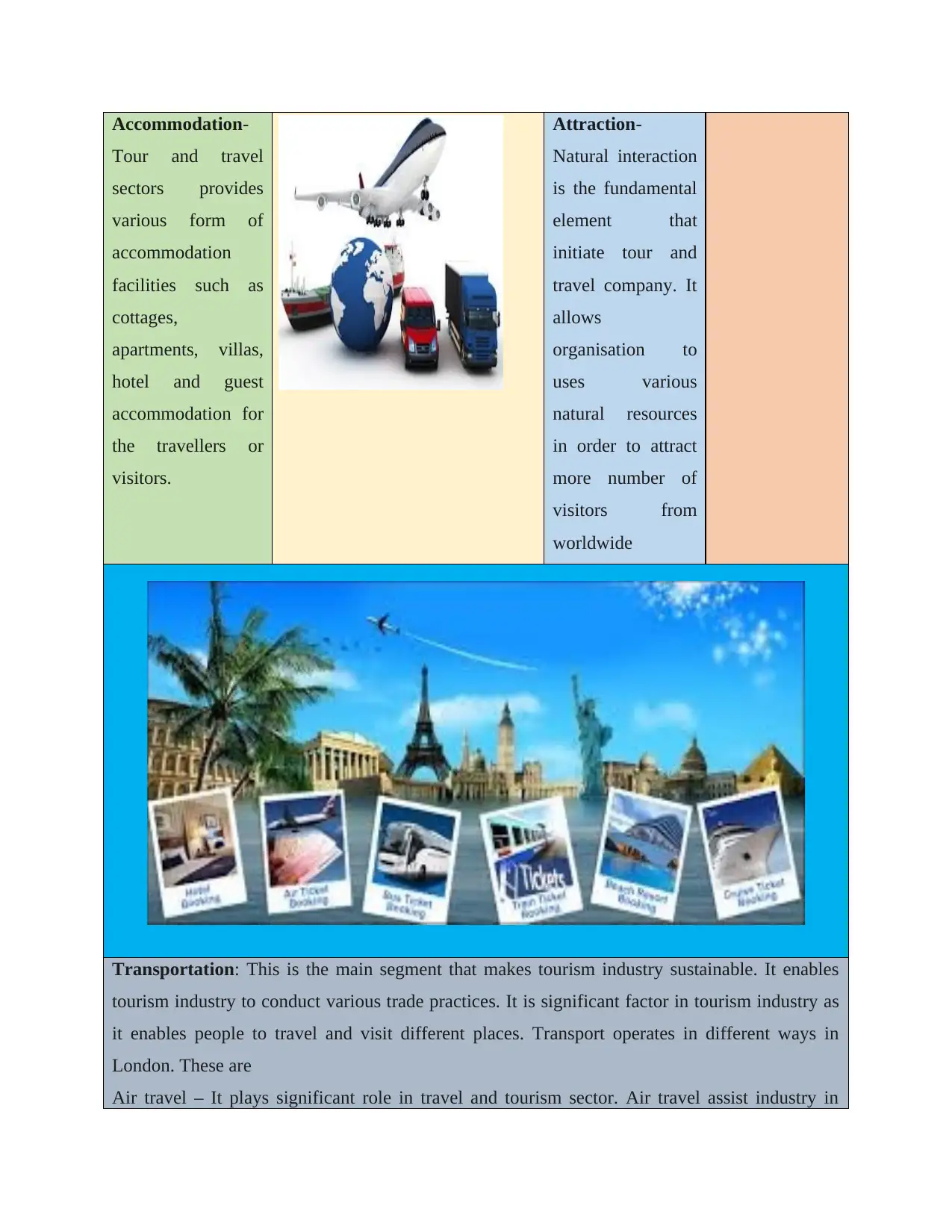
Accommodation-
Tour and travel
sectors provides
various form of
accommodation
facilities such as
cottages,
apartments, villas,
hotel and guest
accommodation for
the travellers or
visitors.
Attraction-
Natural interaction
is the fundamental
element that
initiate tour and
travel company. It
allows
organisation to
uses various
natural resources
in order to attract
more number of
visitors from
worldwide
Transportation: This is the main segment that makes tourism industry sustainable. It enables
tourism industry to conduct various trade practices. It is significant factor in tourism industry as
it enables people to travel and visit different places. Transport operates in different ways in
London. These are
Air travel – It plays significant role in travel and tourism sector. Air travel assist industry in
Tour and travel
sectors provides
various form of
accommodation
facilities such as
cottages,
apartments, villas,
hotel and guest
accommodation for
the travellers or
visitors.
Attraction-
Natural interaction
is the fundamental
element that
initiate tour and
travel company. It
allows
organisation to
uses various
natural resources
in order to attract
more number of
visitors from
worldwide
Transportation: This is the main segment that makes tourism industry sustainable. It enables
tourism industry to conduct various trade practices. It is significant factor in tourism industry as
it enables people to travel and visit different places. Transport operates in different ways in
London. These are
Air travel – It plays significant role in travel and tourism sector. Air travel assist industry in
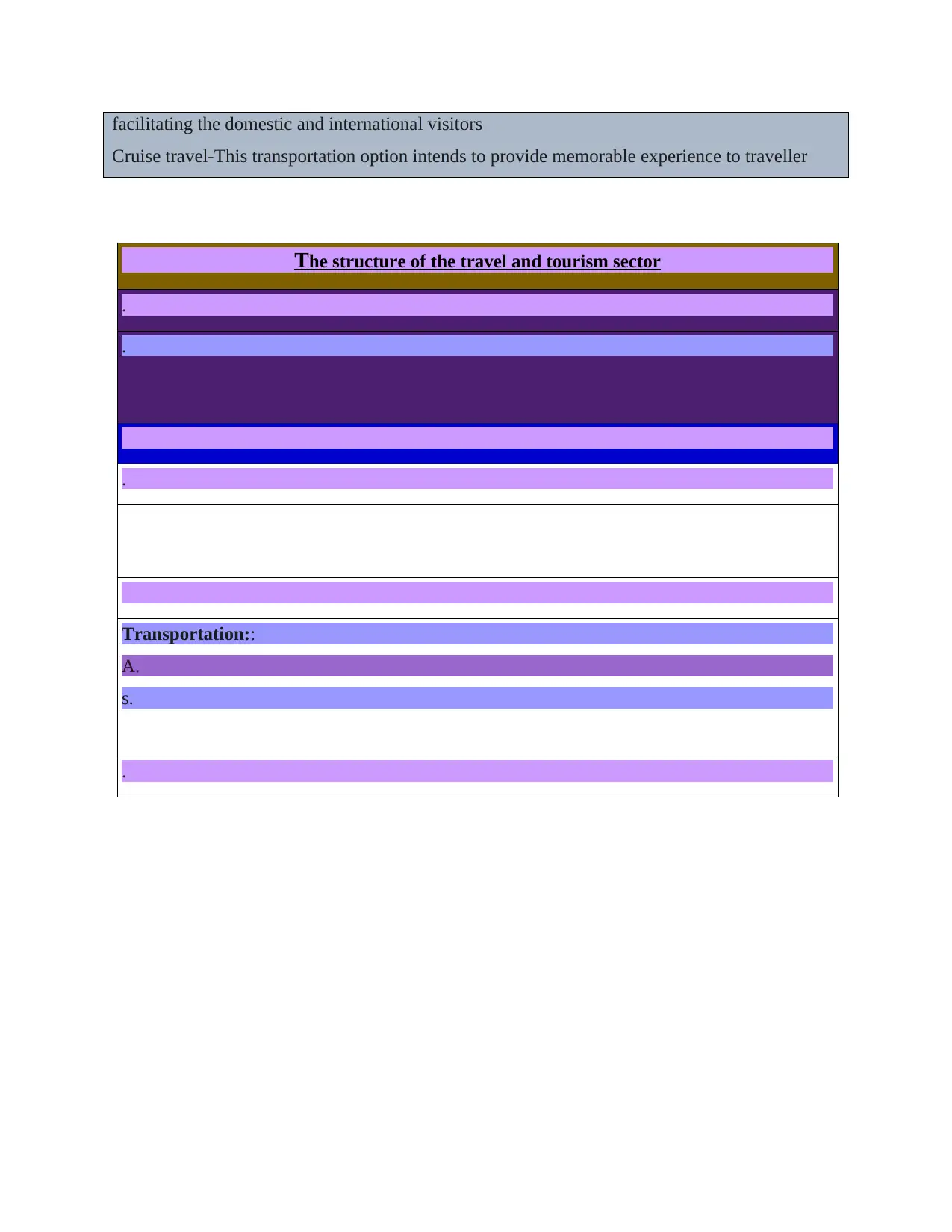
facilitating the domestic and international visitors
Cruise travel-This transportation option intends to provide memorable experience to traveller
The structure of the travel and tourism sector
.
.
.
Transportation::
A.
s.
.
Cruise travel-This transportation option intends to provide memorable experience to traveller
The structure of the travel and tourism sector
.
.
.
Transportation::
A.
s.
.
Paraphrase This Document
Need a fresh take? Get an instant paraphrase of this document with our AI Paraphraser
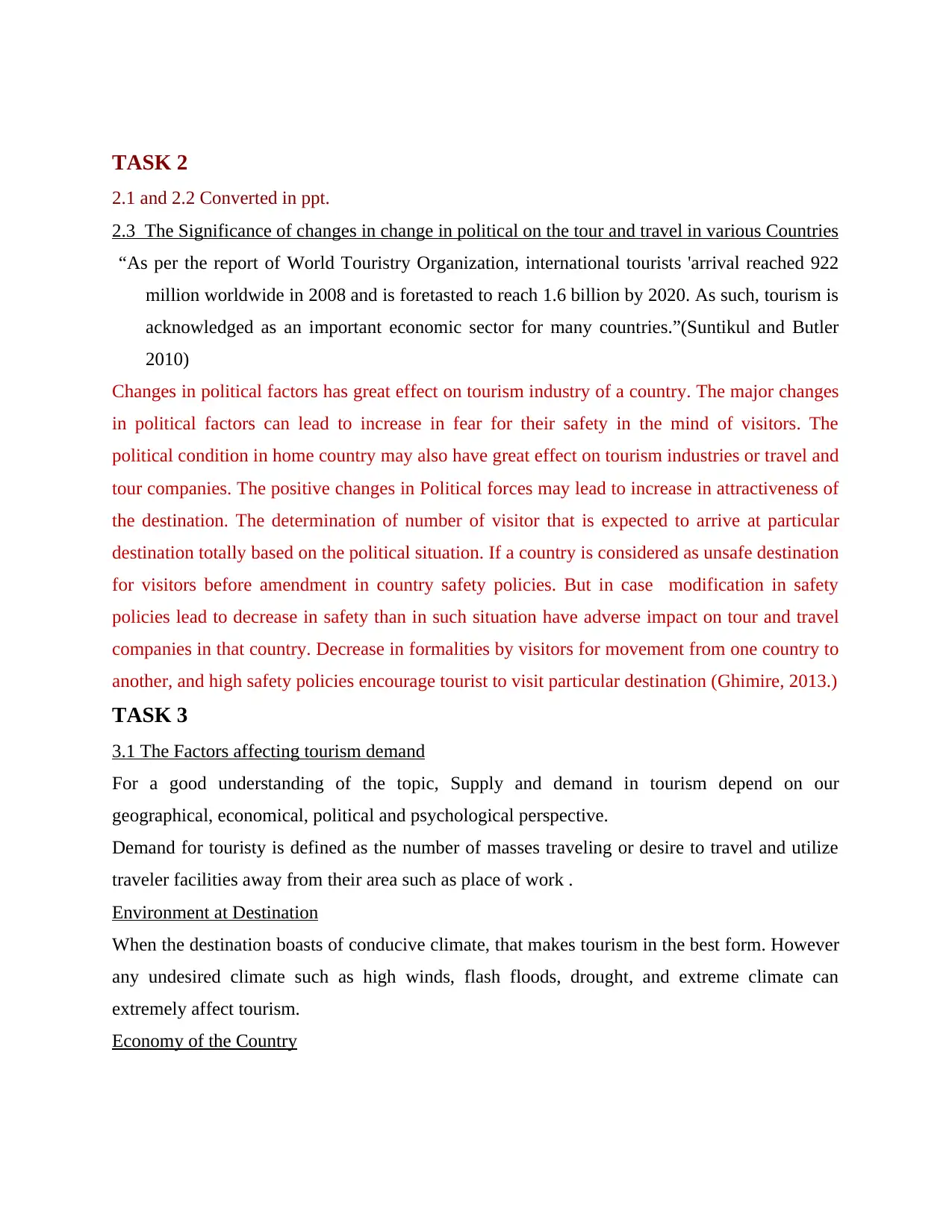
TASK 2
2.1 and 2.2 Converted in ppt.
2.3 The Significance of changes in change in political on the tour and travel in various Countries
“As per the report of World Touristry Organization, international tourists 'arrival reached 922
million worldwide in 2008 and is foretasted to reach 1.6 billion by 2020. As such, tourism is
acknowledged as an important economic sector for many countries.”(Suntikul and Butler
2010)
Changes in political factors has great effect on tourism industry of a country. The major changes
in political factors can lead to increase in fear for their safety in the mind of visitors. The
political condition in home country may also have great effect on tourism industries or travel and
tour companies. The positive changes in Political forces may lead to increase in attractiveness of
the destination. The determination of number of visitor that is expected to arrive at particular
destination totally based on the political situation. If a country is considered as unsafe destination
for visitors before amendment in country safety policies. But in case modification in safety
policies lead to decrease in safety than in such situation have adverse impact on tour and travel
companies in that country. Decrease in formalities by visitors for movement from one country to
another, and high safety policies encourage tourist to visit particular destination (Ghimire, 2013.)
TASK 3
3.1 The Factors affecting tourism demand
For a good understanding of the topic, Supply and demand in tourism depend on our
geographical, economical, political and psychological perspective.
Demand for touristy is defined as the number of masses traveling or desire to travel and utilize
traveler facilities away from their area such as place of work .
Environment at Destination
When the destination boasts of conducive climate, that makes tourism in the best form. However
any undesired climate such as high winds, flash floods, drought, and extreme climate can
extremely affect tourism.
Economy of the Country
2.1 and 2.2 Converted in ppt.
2.3 The Significance of changes in change in political on the tour and travel in various Countries
“As per the report of World Touristry Organization, international tourists 'arrival reached 922
million worldwide in 2008 and is foretasted to reach 1.6 billion by 2020. As such, tourism is
acknowledged as an important economic sector for many countries.”(Suntikul and Butler
2010)
Changes in political factors has great effect on tourism industry of a country. The major changes
in political factors can lead to increase in fear for their safety in the mind of visitors. The
political condition in home country may also have great effect on tourism industries or travel and
tour companies. The positive changes in Political forces may lead to increase in attractiveness of
the destination. The determination of number of visitor that is expected to arrive at particular
destination totally based on the political situation. If a country is considered as unsafe destination
for visitors before amendment in country safety policies. But in case modification in safety
policies lead to decrease in safety than in such situation have adverse impact on tour and travel
companies in that country. Decrease in formalities by visitors for movement from one country to
another, and high safety policies encourage tourist to visit particular destination (Ghimire, 2013.)
TASK 3
3.1 The Factors affecting tourism demand
For a good understanding of the topic, Supply and demand in tourism depend on our
geographical, economical, political and psychological perspective.
Demand for touristy is defined as the number of masses traveling or desire to travel and utilize
traveler facilities away from their area such as place of work .
Environment at Destination
When the destination boasts of conducive climate, that makes tourism in the best form. However
any undesired climate such as high winds, flash floods, drought, and extreme climate can
extremely affect tourism.
Economy of the Country
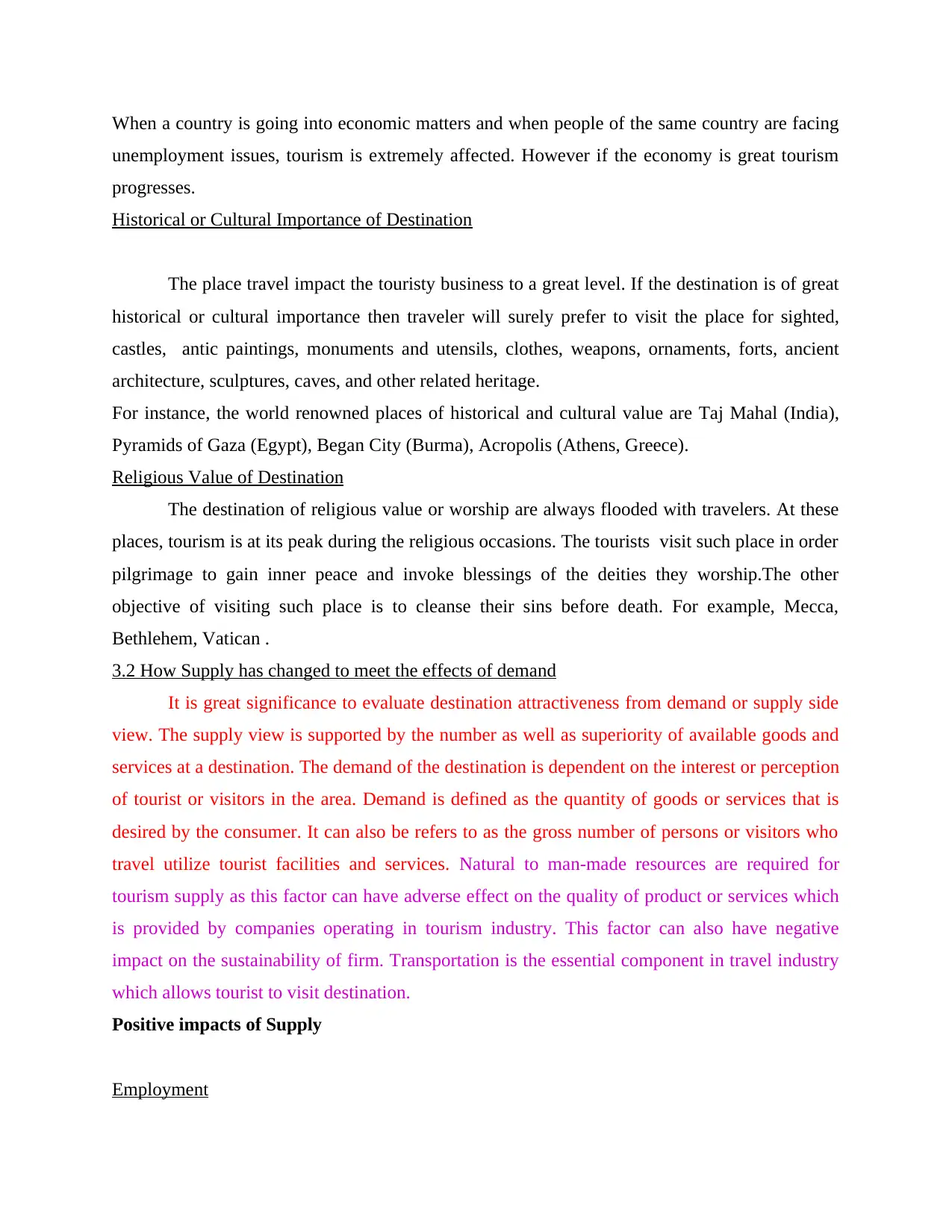
When a country is going into economic matters and when people of the same country are facing
unemployment issues, tourism is extremely affected. However if the economy is great tourism
progresses.
Historical or Cultural Importance of Destination
The place travel impact the touristy business to a great level. If the destination is of great
historical or cultural importance then traveler will surely prefer to visit the place for sighted,
castles, antic paintings, monuments and utensils, clothes, weapons, ornaments, forts, ancient
architecture, sculptures, caves, and other related heritage.
For instance, the world renowned places of historical and cultural value are Taj Mahal (India),
Pyramids of Gaza (Egypt), Began City (Burma), Acropolis (Athens, Greece).
Religious Value of Destination
The destination of religious value or worship are always flooded with travelers. At these
places, tourism is at its peak during the religious occasions. The tourists visit such place in order
pilgrimage to gain inner peace and invoke blessings of the deities they worship.The other
objective of visiting such place is to cleanse their sins before death. For example, Mecca,
Bethlehem, Vatican .
3.2 How Supply has changed to meet the effects of demand
It is great significance to evaluate destination attractiveness from demand or supply side
view. The supply view is supported by the number as well as superiority of available goods and
services at a destination. The demand of the destination is dependent on the interest or perception
of tourist or visitors in the area. Demand is defined as the quantity of goods or services that is
desired by the consumer. It can also be refers to as the gross number of persons or visitors who
travel utilize tourist facilities and services. Natural to man-made resources are required for
tourism supply as this factor can have adverse effect on the quality of product or services which
is provided by companies operating in tourism industry. This factor can also have negative
impact on the sustainability of firm. Transportation is the essential component in travel industry
which allows tourist to visit destination.
Positive impacts of Supply
Employment
unemployment issues, tourism is extremely affected. However if the economy is great tourism
progresses.
Historical or Cultural Importance of Destination
The place travel impact the touristy business to a great level. If the destination is of great
historical or cultural importance then traveler will surely prefer to visit the place for sighted,
castles, antic paintings, monuments and utensils, clothes, weapons, ornaments, forts, ancient
architecture, sculptures, caves, and other related heritage.
For instance, the world renowned places of historical and cultural value are Taj Mahal (India),
Pyramids of Gaza (Egypt), Began City (Burma), Acropolis (Athens, Greece).
Religious Value of Destination
The destination of religious value or worship are always flooded with travelers. At these
places, tourism is at its peak during the religious occasions. The tourists visit such place in order
pilgrimage to gain inner peace and invoke blessings of the deities they worship.The other
objective of visiting such place is to cleanse their sins before death. For example, Mecca,
Bethlehem, Vatican .
3.2 How Supply has changed to meet the effects of demand
It is great significance to evaluate destination attractiveness from demand or supply side
view. The supply view is supported by the number as well as superiority of available goods and
services at a destination. The demand of the destination is dependent on the interest or perception
of tourist or visitors in the area. Demand is defined as the quantity of goods or services that is
desired by the consumer. It can also be refers to as the gross number of persons or visitors who
travel utilize tourist facilities and services. Natural to man-made resources are required for
tourism supply as this factor can have adverse effect on the quality of product or services which
is provided by companies operating in tourism industry. This factor can also have negative
impact on the sustainability of firm. Transportation is the essential component in travel industry
which allows tourist to visit destination.
Positive impacts of Supply
Employment
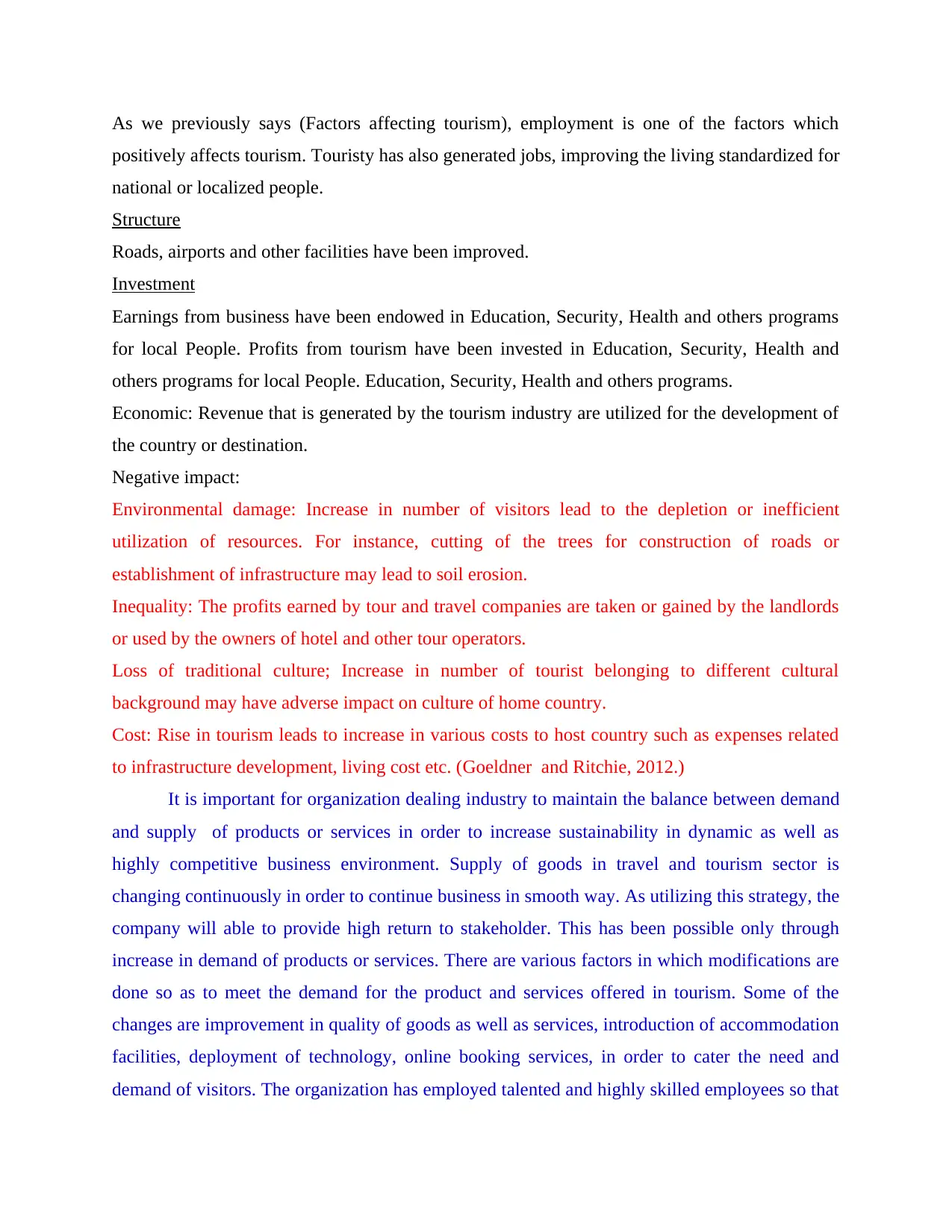
As we previously says (Factors affecting tourism), employment is one of the factors which
positively affects tourism. Touristy has also generated jobs, improving the living standardized for
national or localized people.
Structure
Roads, airports and other facilities have been improved.
Investment
Earnings from business have been endowed in Education, Security, Health and others programs
for local People. Profits from tourism have been invested in Education, Security, Health and
others programs for local People. Education, Security, Health and others programs.
Economic: Revenue that is generated by the tourism industry are utilized for the development of
the country or destination.
Negative impact:
Environmental damage: Increase in number of visitors lead to the depletion or inefficient
utilization of resources. For instance, cutting of the trees for construction of roads or
establishment of infrastructure may lead to soil erosion.
Inequality: The profits earned by tour and travel companies are taken or gained by the landlords
or used by the owners of hotel and other tour operators.
Loss of traditional culture; Increase in number of tourist belonging to different cultural
background may have adverse impact on culture of home country.
Cost: Rise in tourism leads to increase in various costs to host country such as expenses related
to infrastructure development, living cost etc. (Goeldner and Ritchie, 2012.)
It is important for organization dealing industry to maintain the balance between demand
and supply of products or services in order to increase sustainability in dynamic as well as
highly competitive business environment. Supply of goods in travel and tourism sector is
changing continuously in order to continue business in smooth way. As utilizing this strategy, the
company will able to provide high return to stakeholder. This has been possible only through
increase in demand of products or services. There are various factors in which modifications are
done so as to meet the demand for the product and services offered in tourism. Some of the
changes are improvement in quality of goods as well as services, introduction of accommodation
facilities, deployment of technology, online booking services, in order to cater the need and
demand of visitors. The organization has employed talented and highly skilled employees so that
positively affects tourism. Touristy has also generated jobs, improving the living standardized for
national or localized people.
Structure
Roads, airports and other facilities have been improved.
Investment
Earnings from business have been endowed in Education, Security, Health and others programs
for local People. Profits from tourism have been invested in Education, Security, Health and
others programs for local People. Education, Security, Health and others programs.
Economic: Revenue that is generated by the tourism industry are utilized for the development of
the country or destination.
Negative impact:
Environmental damage: Increase in number of visitors lead to the depletion or inefficient
utilization of resources. For instance, cutting of the trees for construction of roads or
establishment of infrastructure may lead to soil erosion.
Inequality: The profits earned by tour and travel companies are taken or gained by the landlords
or used by the owners of hotel and other tour operators.
Loss of traditional culture; Increase in number of tourist belonging to different cultural
background may have adverse impact on culture of home country.
Cost: Rise in tourism leads to increase in various costs to host country such as expenses related
to infrastructure development, living cost etc. (Goeldner and Ritchie, 2012.)
It is important for organization dealing industry to maintain the balance between demand
and supply of products or services in order to increase sustainability in dynamic as well as
highly competitive business environment. Supply of goods in travel and tourism sector is
changing continuously in order to continue business in smooth way. As utilizing this strategy, the
company will able to provide high return to stakeholder. This has been possible only through
increase in demand of products or services. There are various factors in which modifications are
done so as to meet the demand for the product and services offered in tourism. Some of the
changes are improvement in quality of goods as well as services, introduction of accommodation
facilities, deployment of technology, online booking services, in order to cater the need and
demand of visitors. The organization has employed talented and highly skilled employees so that
Secure Best Marks with AI Grader
Need help grading? Try our AI Grader for instant feedback on your assignments.
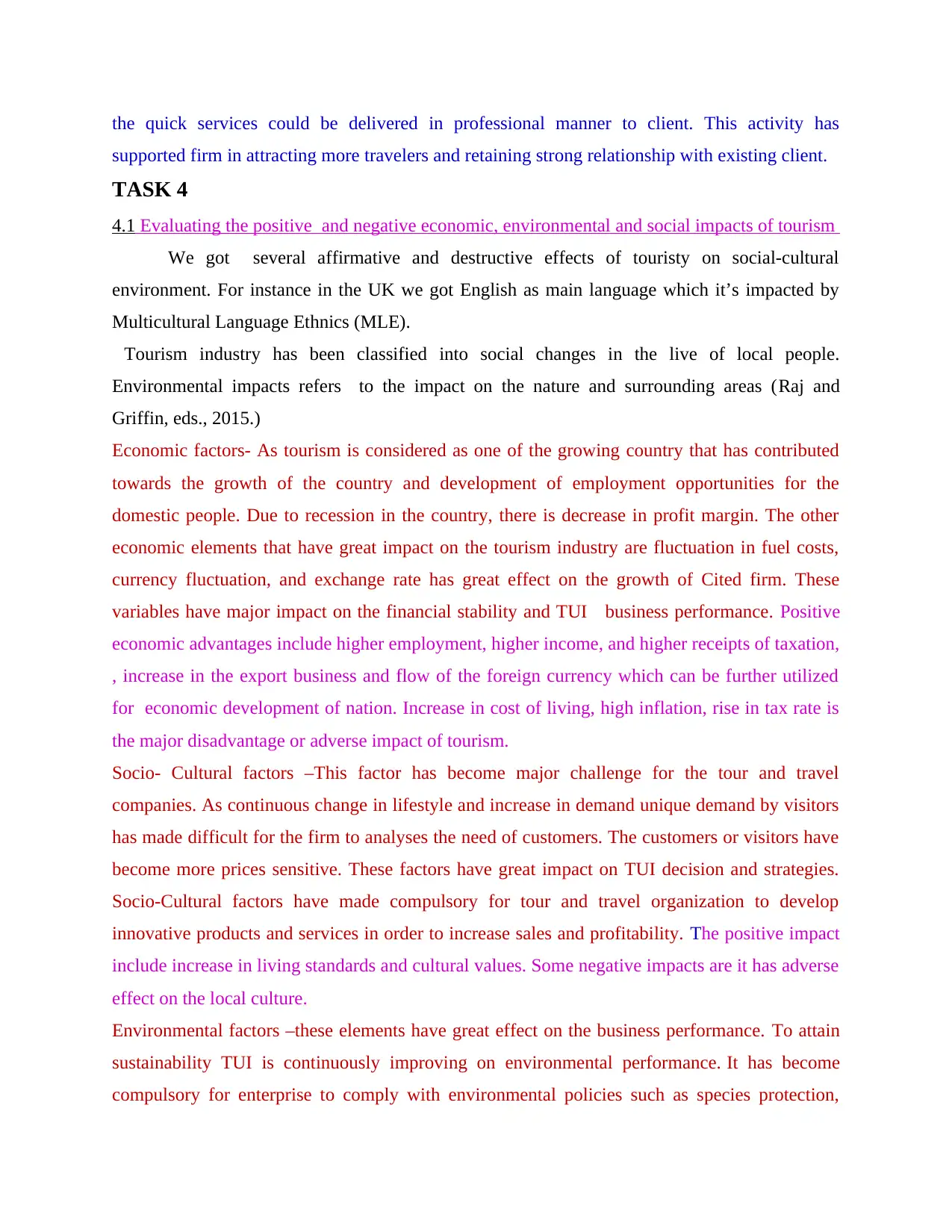
the quick services could be delivered in professional manner to client. This activity has
supported firm in attracting more travelers and retaining strong relationship with existing client.
TASK 4
4.1 Evaluating the positive and negative economic, environmental and social impacts of tourism
We got several affirmative and destructive effects of touristy on social-cultural
environment. For instance in the UK we got English as main language which it’s impacted by
Multicultural Language Ethnics (MLE).
Tourism industry has been classified into social changes in the live of local people.
Environmental impacts refers to the impact on the nature and surrounding areas (Raj and
Griffin, eds., 2015.)
Economic factors- As tourism is considered as one of the growing country that has contributed
towards the growth of the country and development of employment opportunities for the
domestic people. Due to recession in the country, there is decrease in profit margin. The other
economic elements that have great impact on the tourism industry are fluctuation in fuel costs,
currency fluctuation, and exchange rate has great effect on the growth of Cited firm. These
variables have major impact on the financial stability and TUI business performance. Positive
economic advantages include higher employment, higher income, and higher receipts of taxation,
, increase in the export business and flow of the foreign currency which can be further utilized
for economic development of nation. Increase in cost of living, high inflation, rise in tax rate is
the major disadvantage or adverse impact of tourism.
Socio- Cultural factors –This factor has become major challenge for the tour and travel
companies. As continuous change in lifestyle and increase in demand unique demand by visitors
has made difficult for the firm to analyses the need of customers. The customers or visitors have
become more prices sensitive. These factors have great impact on TUI decision and strategies.
Socio-Cultural factors have made compulsory for tour and travel organization to develop
innovative products and services in order to increase sales and profitability. The positive impact
include increase in living standards and cultural values. Some negative impacts are it has adverse
effect on the local culture.
Environmental factors –these elements have great effect on the business performance. To attain
sustainability TUI is continuously improving on environmental performance. It has become
compulsory for enterprise to comply with environmental policies such as species protection,
supported firm in attracting more travelers and retaining strong relationship with existing client.
TASK 4
4.1 Evaluating the positive and negative economic, environmental and social impacts of tourism
We got several affirmative and destructive effects of touristy on social-cultural
environment. For instance in the UK we got English as main language which it’s impacted by
Multicultural Language Ethnics (MLE).
Tourism industry has been classified into social changes in the live of local people.
Environmental impacts refers to the impact on the nature and surrounding areas (Raj and
Griffin, eds., 2015.)
Economic factors- As tourism is considered as one of the growing country that has contributed
towards the growth of the country and development of employment opportunities for the
domestic people. Due to recession in the country, there is decrease in profit margin. The other
economic elements that have great impact on the tourism industry are fluctuation in fuel costs,
currency fluctuation, and exchange rate has great effect on the growth of Cited firm. These
variables have major impact on the financial stability and TUI business performance. Positive
economic advantages include higher employment, higher income, and higher receipts of taxation,
, increase in the export business and flow of the foreign currency which can be further utilized
for economic development of nation. Increase in cost of living, high inflation, rise in tax rate is
the major disadvantage or adverse impact of tourism.
Socio- Cultural factors –This factor has become major challenge for the tour and travel
companies. As continuous change in lifestyle and increase in demand unique demand by visitors
has made difficult for the firm to analyses the need of customers. The customers or visitors have
become more prices sensitive. These factors have great impact on TUI decision and strategies.
Socio-Cultural factors have made compulsory for tour and travel organization to develop
innovative products and services in order to increase sales and profitability. The positive impact
include increase in living standards and cultural values. Some negative impacts are it has adverse
effect on the local culture.
Environmental factors –these elements have great effect on the business performance. To attain
sustainability TUI is continuously improving on environmental performance. It has become
compulsory for enterprise to comply with environmental policies such as species protection,
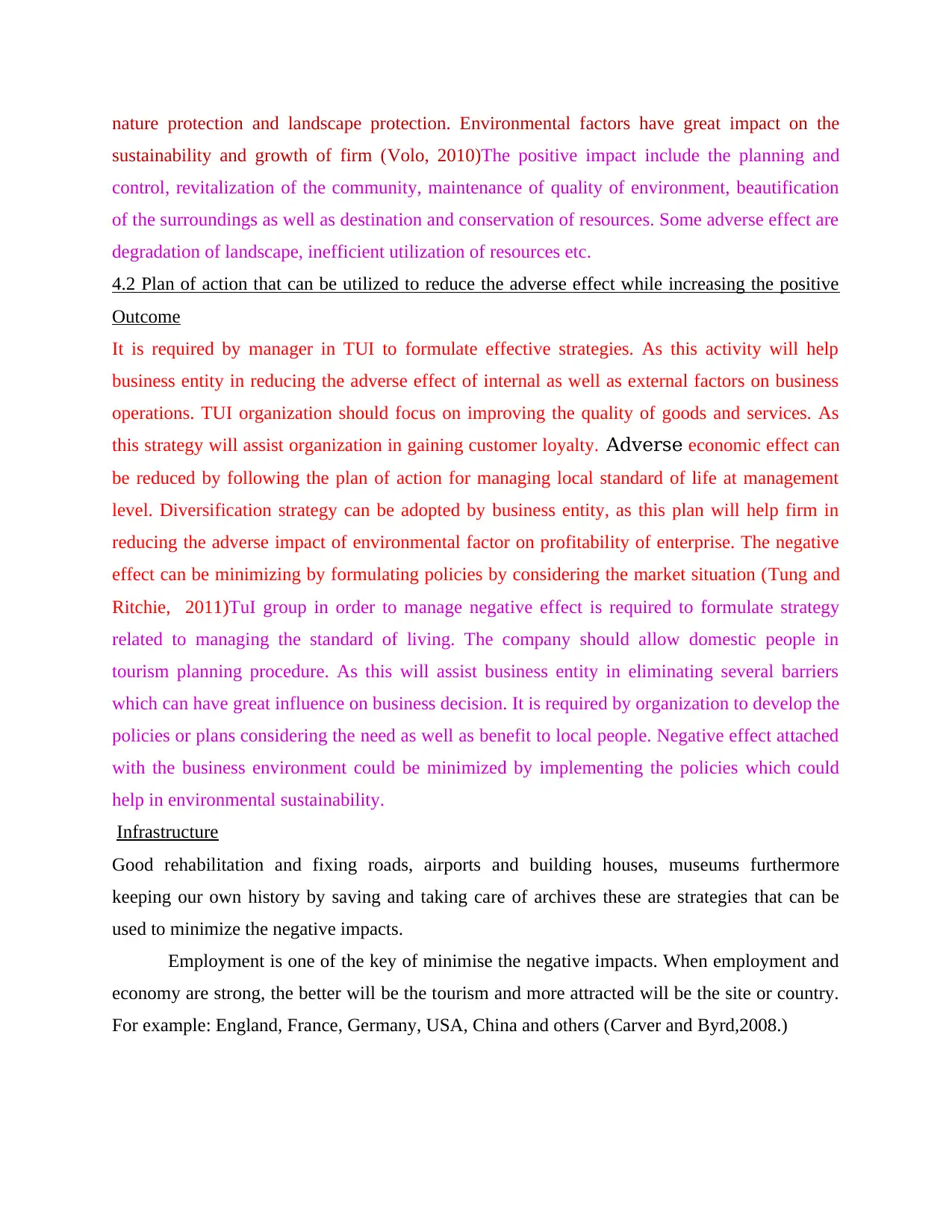
nature protection and landscape protection. Environmental factors have great impact on the
sustainability and growth of firm (Volo, 2010)The positive impact include the planning and
control, revitalization of the community, maintenance of quality of environment, beautification
of the surroundings as well as destination and conservation of resources. Some adverse effect are
degradation of landscape, inefficient utilization of resources etc.
4.2 Plan of action that can be utilized to reduce the adverse effect while increasing the positive
Outcome
It is required by manager in TUI to formulate effective strategies. As this activity will help
business entity in reducing the adverse effect of internal as well as external factors on business
operations. TUI organization should focus on improving the quality of goods and services. As
this strategy will assist organization in gaining customer loyalty. Adverse economic effect can
be reduced by following the plan of action for managing local standard of life at management
level. Diversification strategy can be adopted by business entity, as this plan will help firm in
reducing the adverse impact of environmental factor on profitability of enterprise. The negative
effect can be minimizing by formulating policies by considering the market situation (Tung and
Ritchie, 2011)TuI group in order to manage negative effect is required to formulate strategy
related to managing the standard of living. The company should allow domestic people in
tourism planning procedure. As this will assist business entity in eliminating several barriers
which can have great influence on business decision. It is required by organization to develop the
policies or plans considering the need as well as benefit to local people. Negative effect attached
with the business environment could be minimized by implementing the policies which could
help in environmental sustainability.
Infrastructure
Good rehabilitation and fixing roads, airports and building houses, museums furthermore
keeping our own history by saving and taking care of archives these are strategies that can be
used to minimize the negative impacts.
Employment is one of the key of minimise the negative impacts. When employment and
economy are strong, the better will be the tourism and more attracted will be the site or country.
For example: England, France, Germany, USA, China and others (Carver and Byrd,2008.)
sustainability and growth of firm (Volo, 2010)The positive impact include the planning and
control, revitalization of the community, maintenance of quality of environment, beautification
of the surroundings as well as destination and conservation of resources. Some adverse effect are
degradation of landscape, inefficient utilization of resources etc.
4.2 Plan of action that can be utilized to reduce the adverse effect while increasing the positive
Outcome
It is required by manager in TUI to formulate effective strategies. As this activity will help
business entity in reducing the adverse effect of internal as well as external factors on business
operations. TUI organization should focus on improving the quality of goods and services. As
this strategy will assist organization in gaining customer loyalty. Adverse economic effect can
be reduced by following the plan of action for managing local standard of life at management
level. Diversification strategy can be adopted by business entity, as this plan will help firm in
reducing the adverse impact of environmental factor on profitability of enterprise. The negative
effect can be minimizing by formulating policies by considering the market situation (Tung and
Ritchie, 2011)TuI group in order to manage negative effect is required to formulate strategy
related to managing the standard of living. The company should allow domestic people in
tourism planning procedure. As this will assist business entity in eliminating several barriers
which can have great influence on business decision. It is required by organization to develop the
policies or plans considering the need as well as benefit to local people. Negative effect attached
with the business environment could be minimized by implementing the policies which could
help in environmental sustainability.
Infrastructure
Good rehabilitation and fixing roads, airports and building houses, museums furthermore
keeping our own history by saving and taking care of archives these are strategies that can be
used to minimize the negative impacts.
Employment is one of the key of minimise the negative impacts. When employment and
economy are strong, the better will be the tourism and more attracted will be the site or country.
For example: England, France, Germany, USA, China and others (Carver and Byrd,2008.)
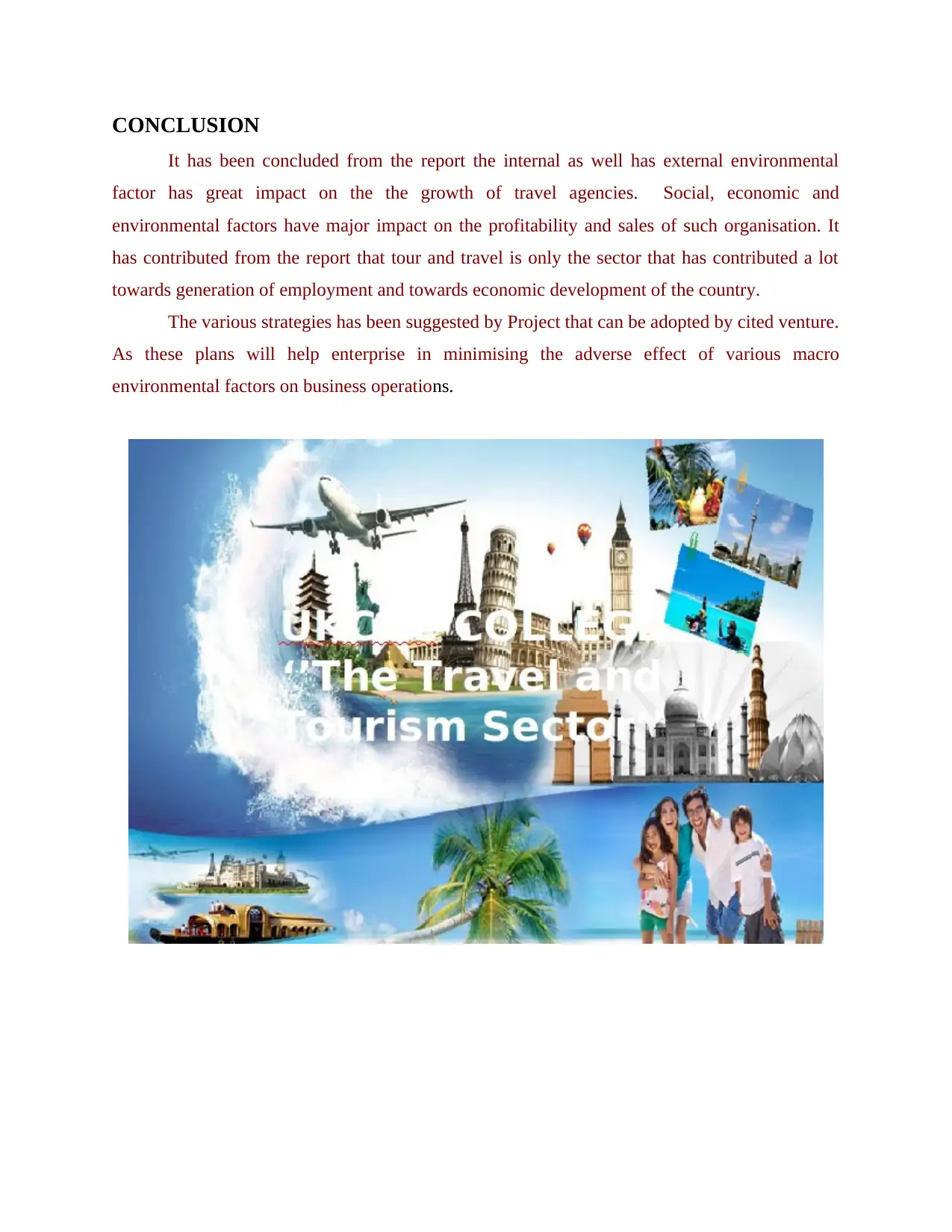
CONCLUSION
It has been concluded from the report the internal as well has external environmental
factor has great impact on the the growth of travel agencies. Social, economic and
environmental factors have major impact on the profitability and sales of such organisation. It
has contributed from the report that tour and travel is only the sector that has contributed a lot
towards generation of employment and towards economic development of the country.
The various strategies has been suggested by Project that can be adopted by cited venture.
As these plans will help enterprise in minimising the adverse effect of various macro
environmental factors on business operations.
It has been concluded from the report the internal as well has external environmental
factor has great impact on the the growth of travel agencies. Social, economic and
environmental factors have major impact on the profitability and sales of such organisation. It
has contributed from the report that tour and travel is only the sector that has contributed a lot
towards generation of employment and towards economic development of the country.
The various strategies has been suggested by Project that can be adopted by cited venture.
As these plans will help enterprise in minimising the adverse effect of various macro
environmental factors on business operations.
Paraphrase This Document
Need a fresh take? Get an instant paraphrase of this document with our AI Paraphraser
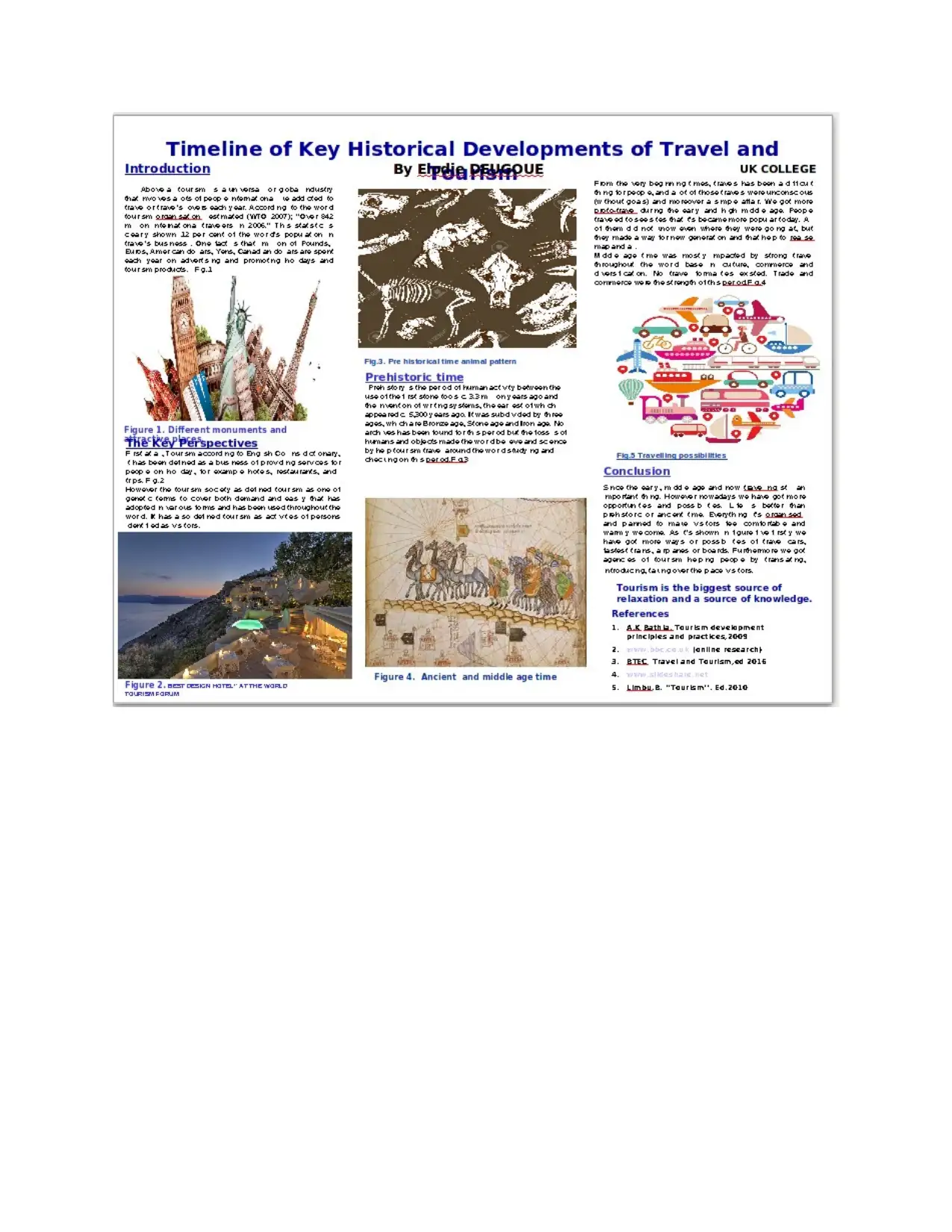
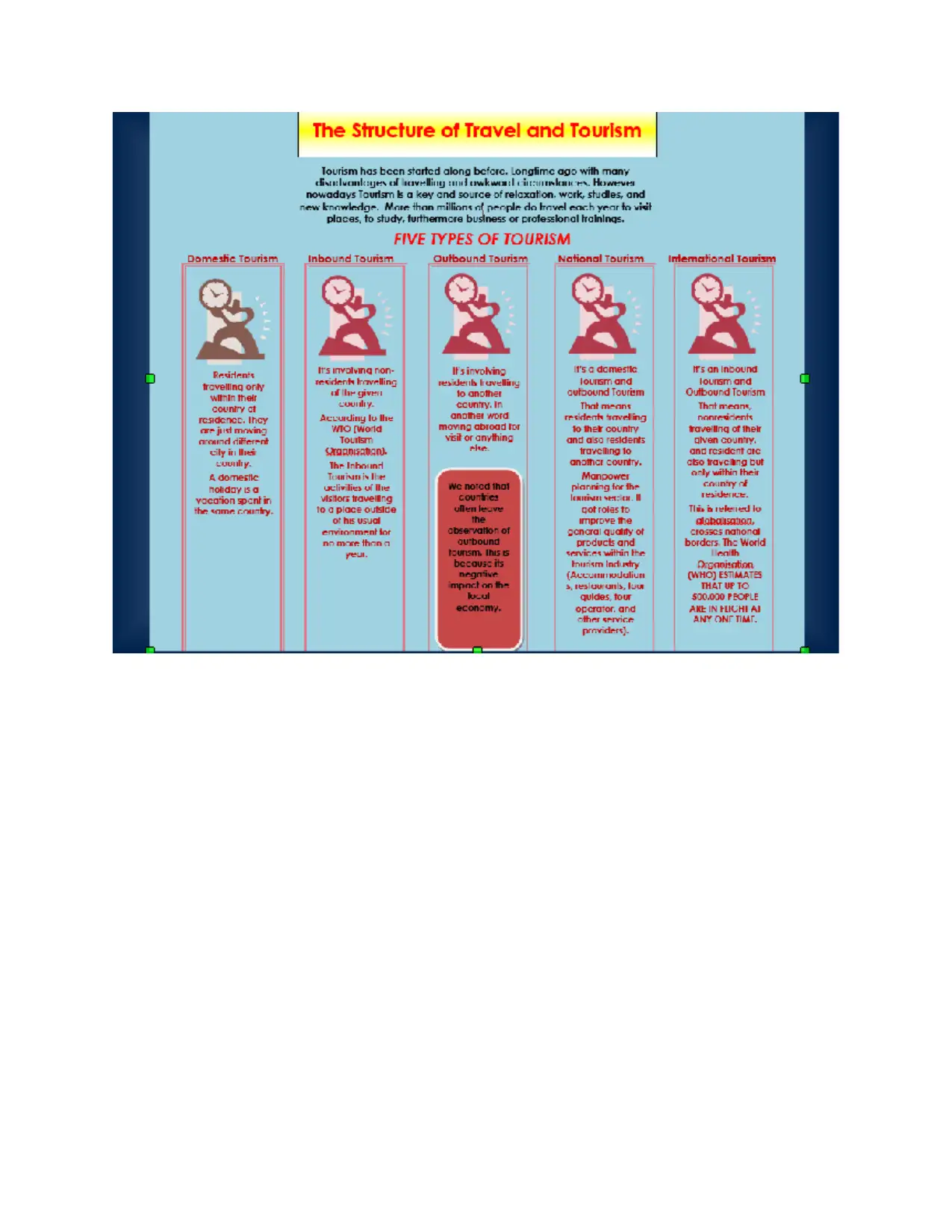
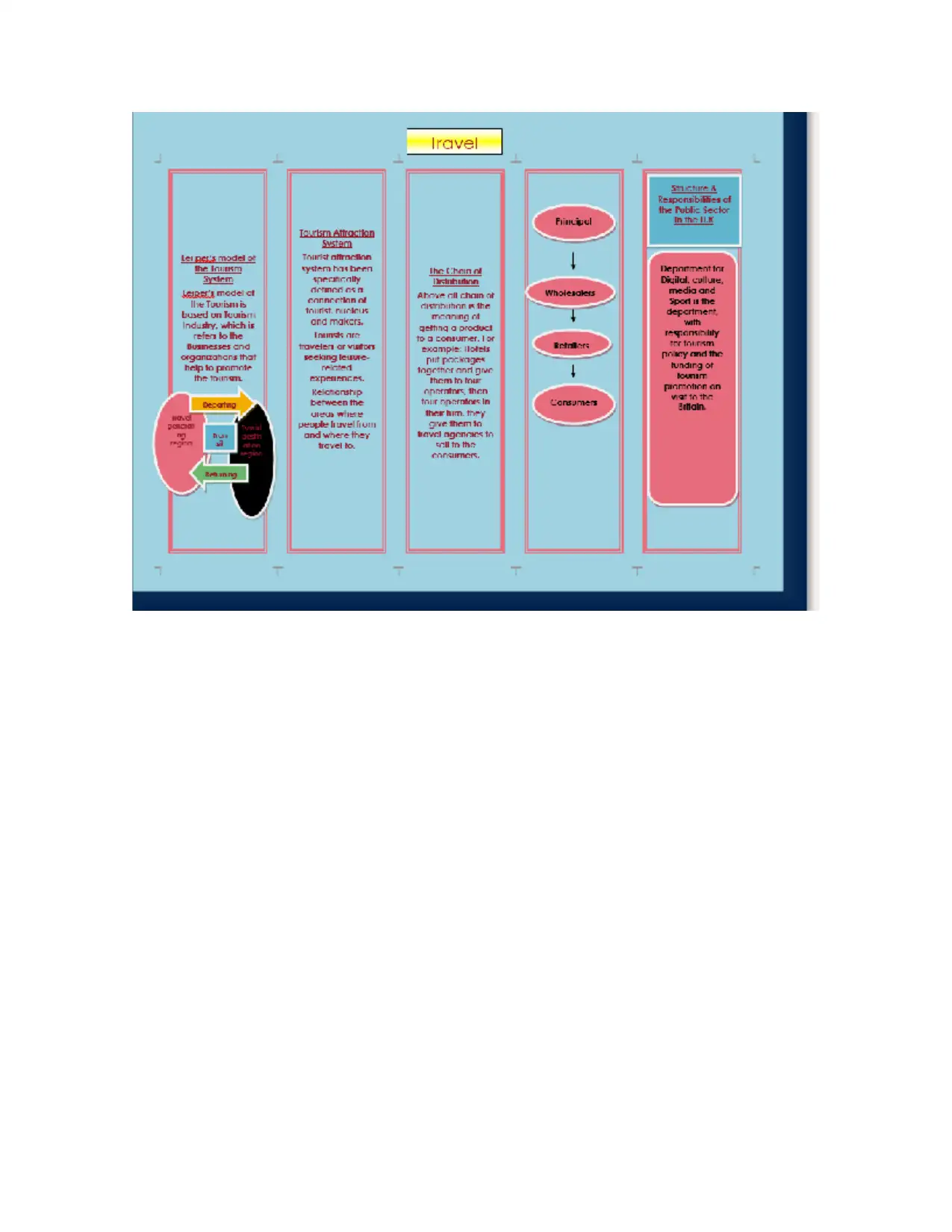
Secure Best Marks with AI Grader
Need help grading? Try our AI Grader for instant feedback on your assignments.
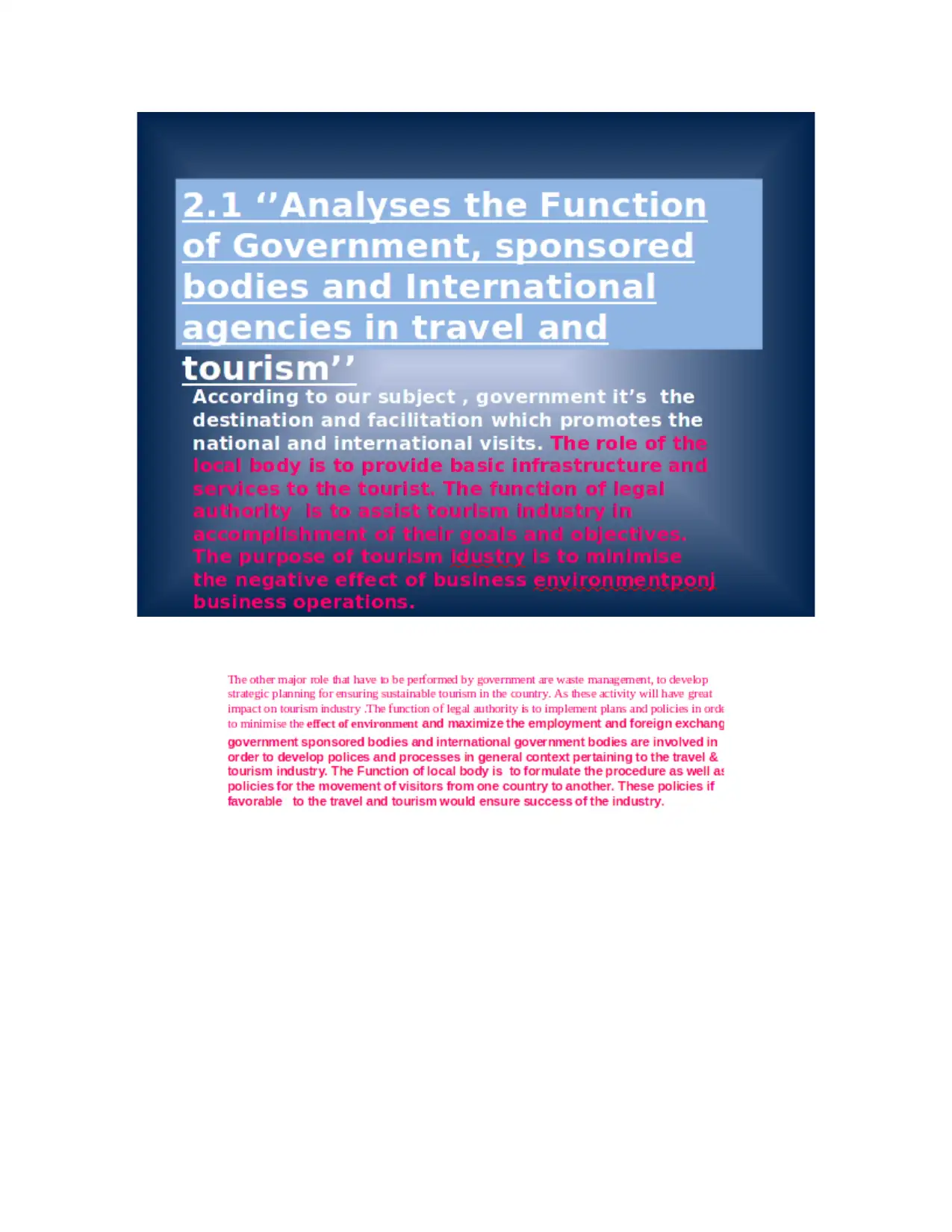
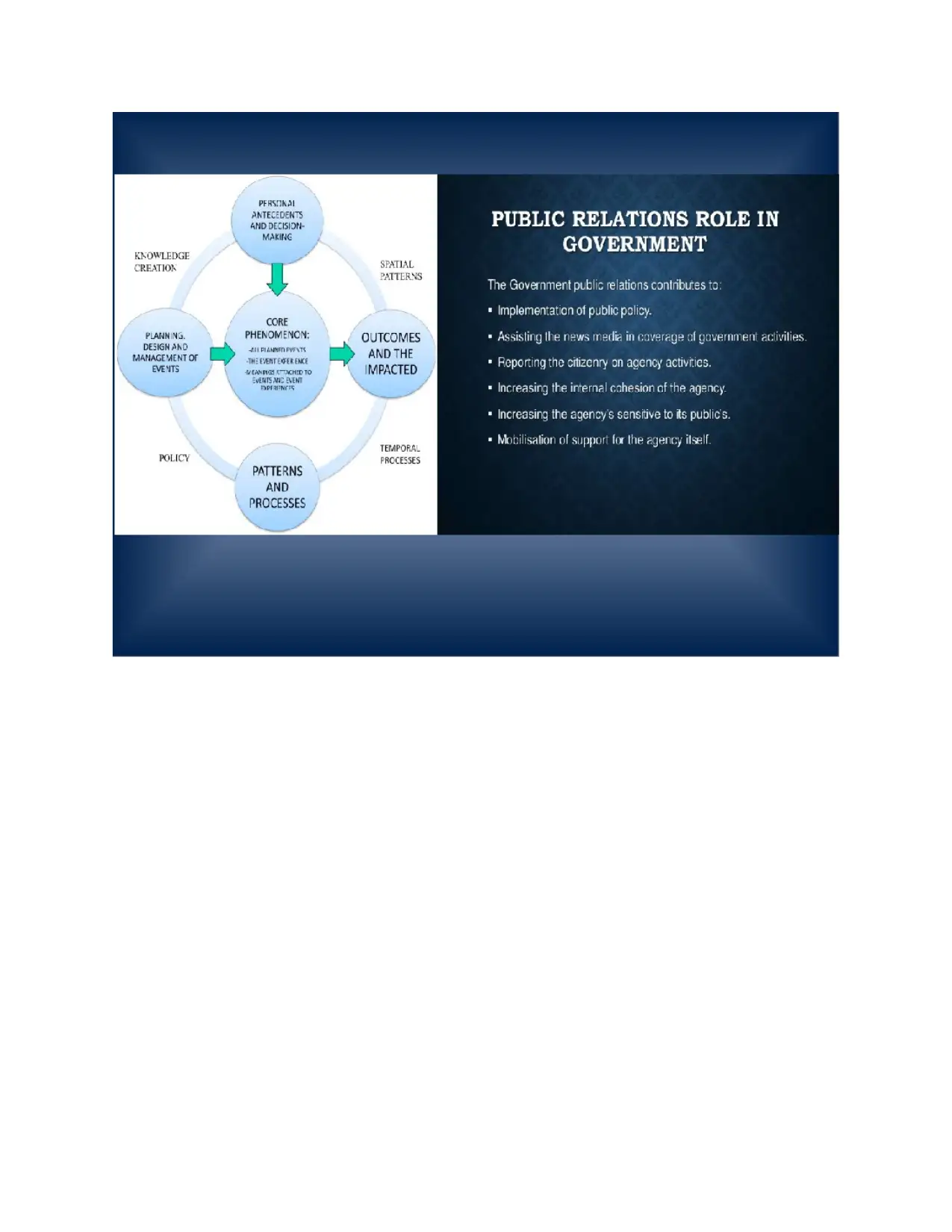
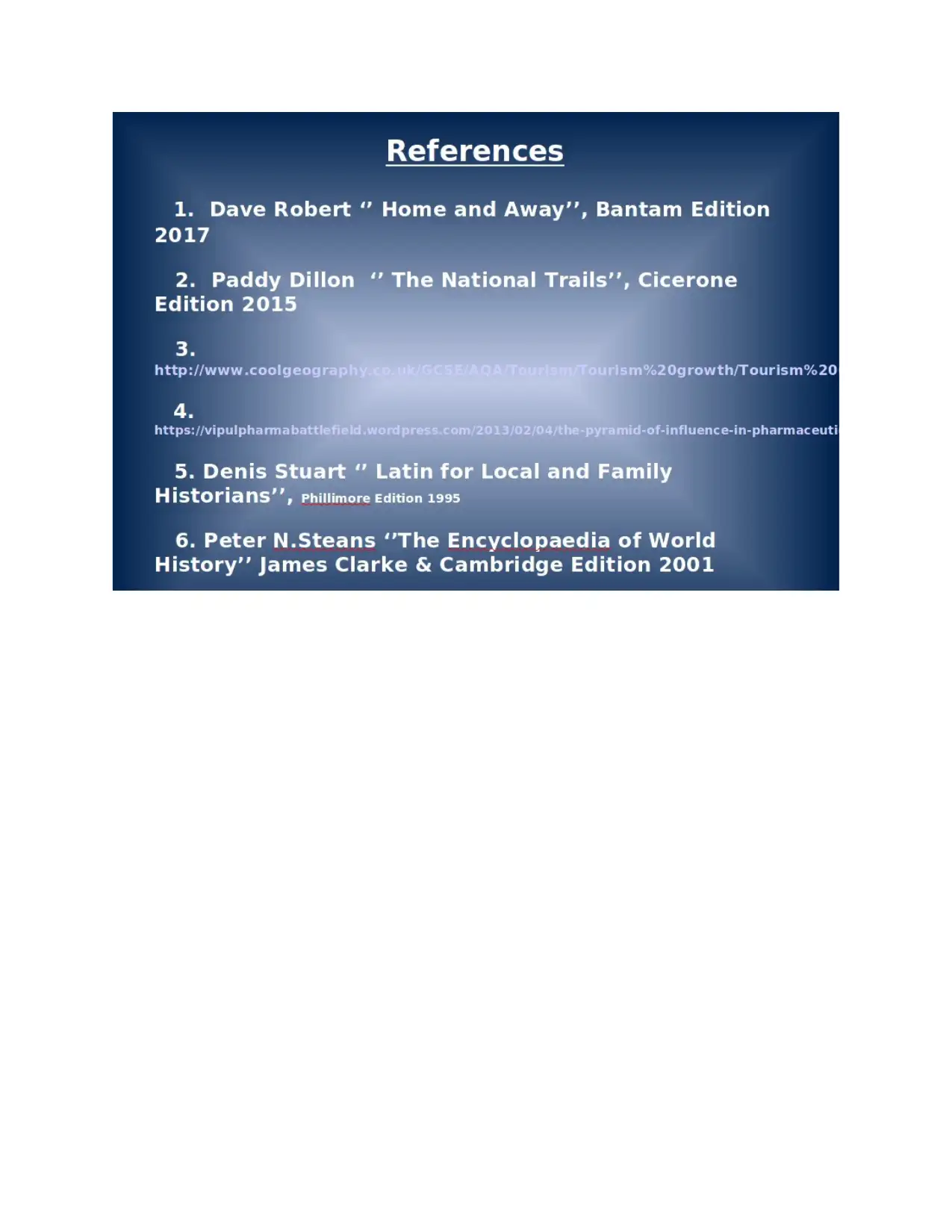
Paraphrase This Document
Need a fresh take? Get an instant paraphrase of this document with our AI Paraphraser
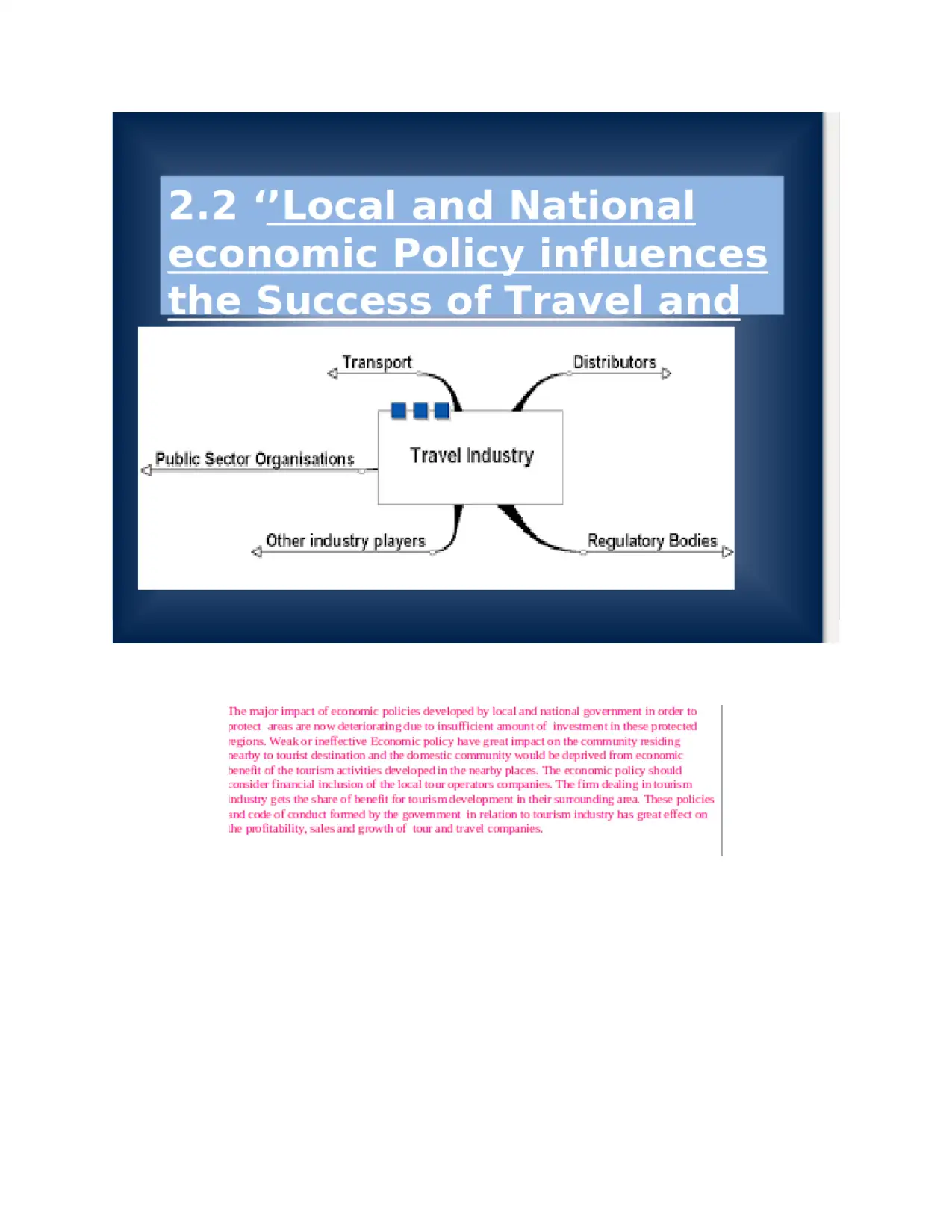
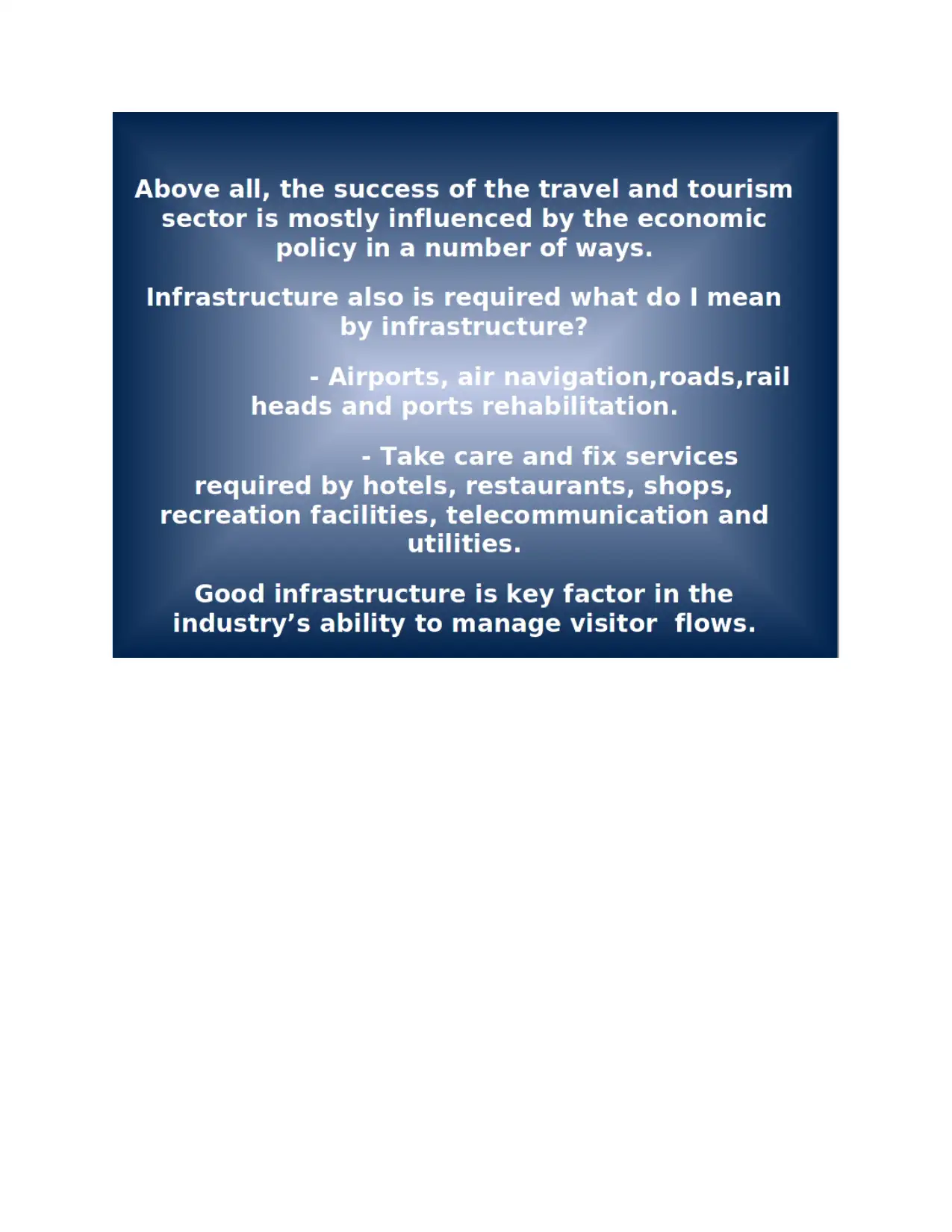
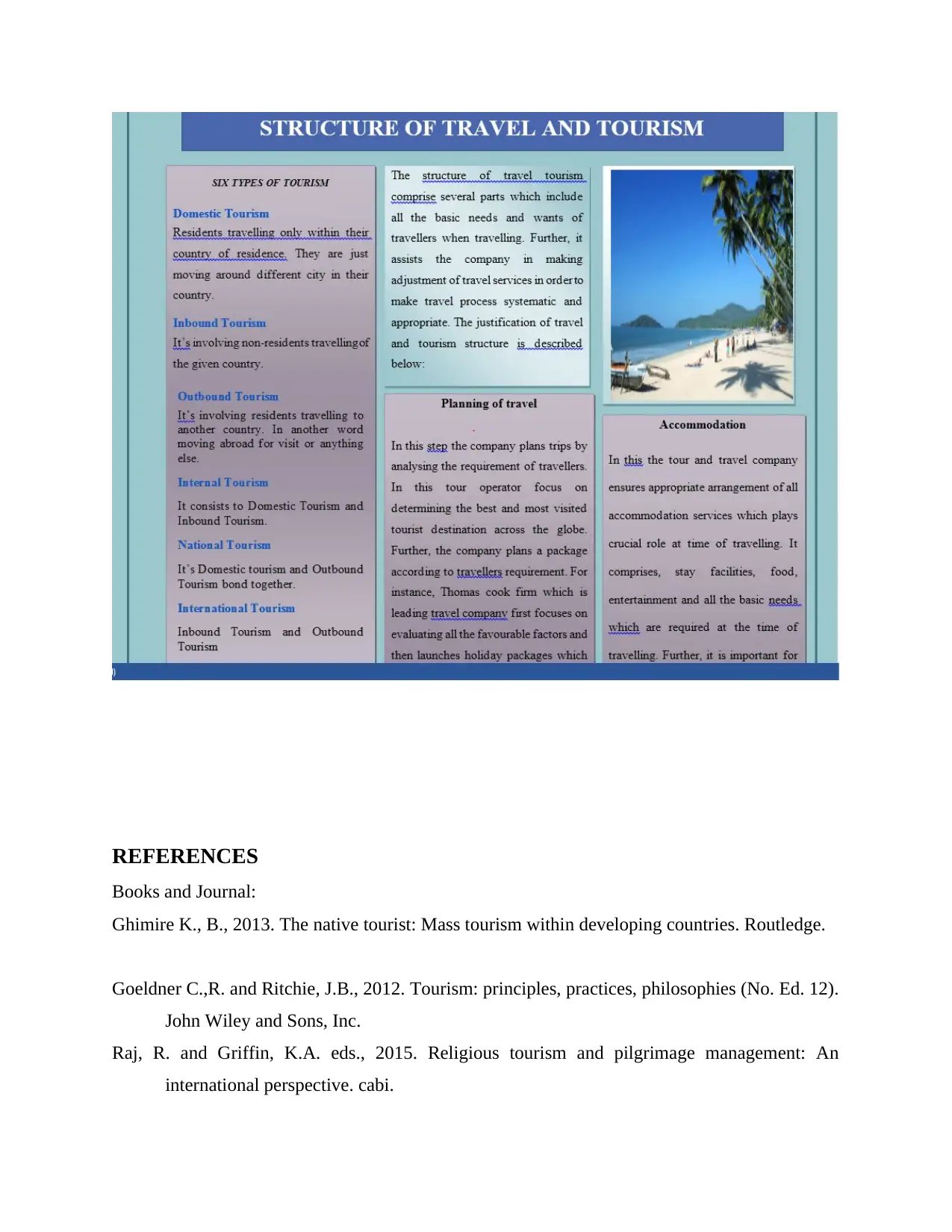
REFERENCES
Books and Journal:
Ghimire K., B., 2013. The native tourist: Mass tourism within developing countries. Routledge.
Goeldner C.,R. and Ritchie, J.B., 2012. Tourism: principles, practices, philosophies (No. Ed. 12).
John Wiley and Sons, Inc.
Raj, R. and Griffin, K.A. eds., 2015. Religious tourism and pilgrimage management: An
international perspective. cabi.
Books and Journal:
Ghimire K., B., 2013. The native tourist: Mass tourism within developing countries. Routledge.
Goeldner C.,R. and Ritchie, J.B., 2012. Tourism: principles, practices, philosophies (No. Ed. 12).
John Wiley and Sons, Inc.
Raj, R. and Griffin, K.A. eds., 2015. Religious tourism and pilgrimage management: An
international perspective. cabi.
Secure Best Marks with AI Grader
Need help grading? Try our AI Grader for instant feedback on your assignments.
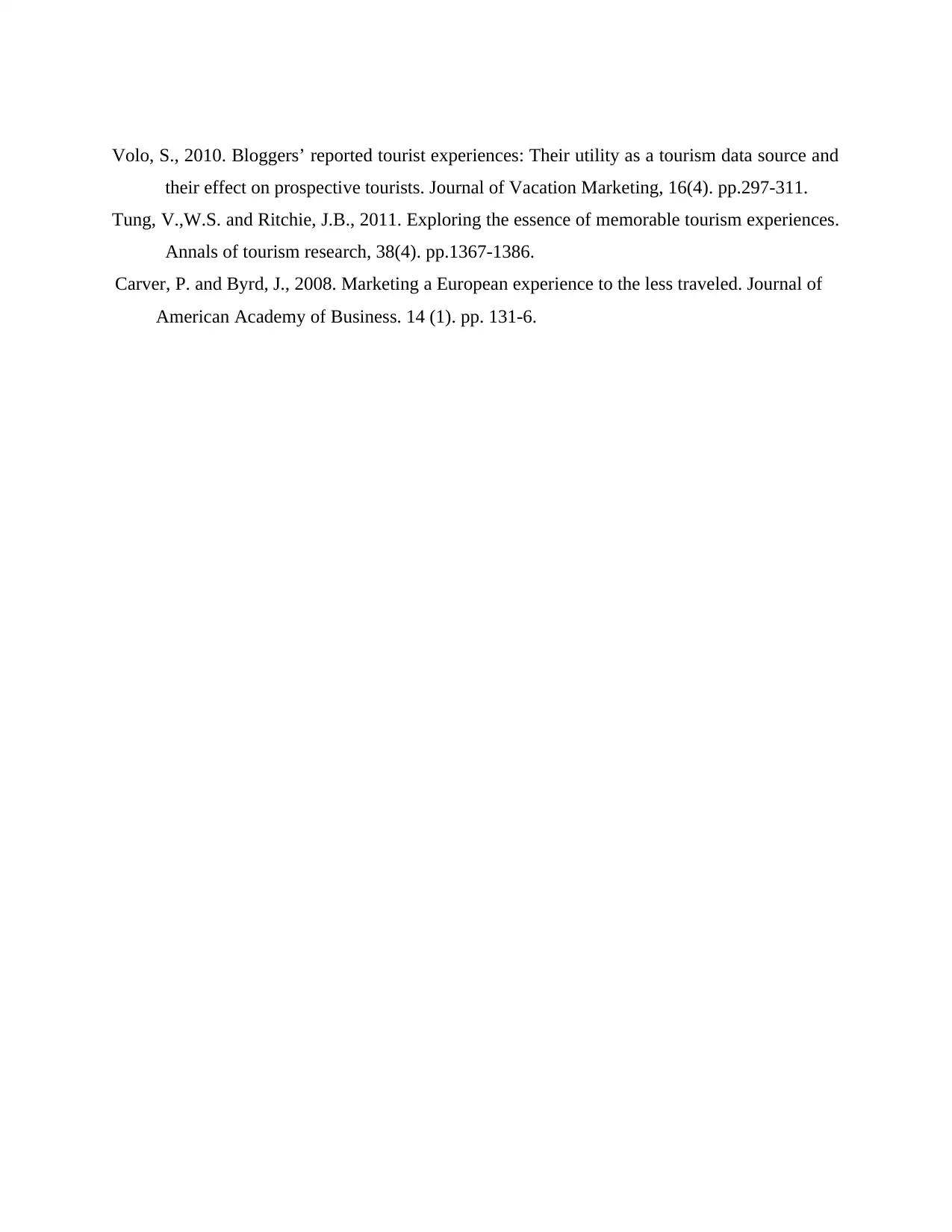
Volo, S., 2010. Bloggers’ reported tourist experiences: Their utility as a tourism data source and
their effect on prospective tourists. Journal of Vacation Marketing, 16(4). pp.297-311.
Tung, V.,W.S. and Ritchie, J.B., 2011. Exploring the essence of memorable tourism experiences.
Annals of tourism research, 38(4). pp.1367-1386.
Carver, P. and Byrd, J., 2008. Marketing a European experience to the less traveled. Journal of
American Academy of Business. 14 (1). pp. 131‐6.
their effect on prospective tourists. Journal of Vacation Marketing, 16(4). pp.297-311.
Tung, V.,W.S. and Ritchie, J.B., 2011. Exploring the essence of memorable tourism experiences.
Annals of tourism research, 38(4). pp.1367-1386.
Carver, P. and Byrd, J., 2008. Marketing a European experience to the less traveled. Journal of
American Academy of Business. 14 (1). pp. 131‐6.
1 out of 23
Related Documents
Your All-in-One AI-Powered Toolkit for Academic Success.
+13062052269
info@desklib.com
Available 24*7 on WhatsApp / Email
![[object Object]](/_next/static/media/star-bottom.7253800d.svg)
Unlock your academic potential
© 2024 | Zucol Services PVT LTD | All rights reserved.





